WINIA Electronics 7NF92MO1000 MICROWAVE OVEN User Manual Users manual
Dongbu Daewoo Electronics Corporation MICROWAVE OVEN Users manual
Users manual
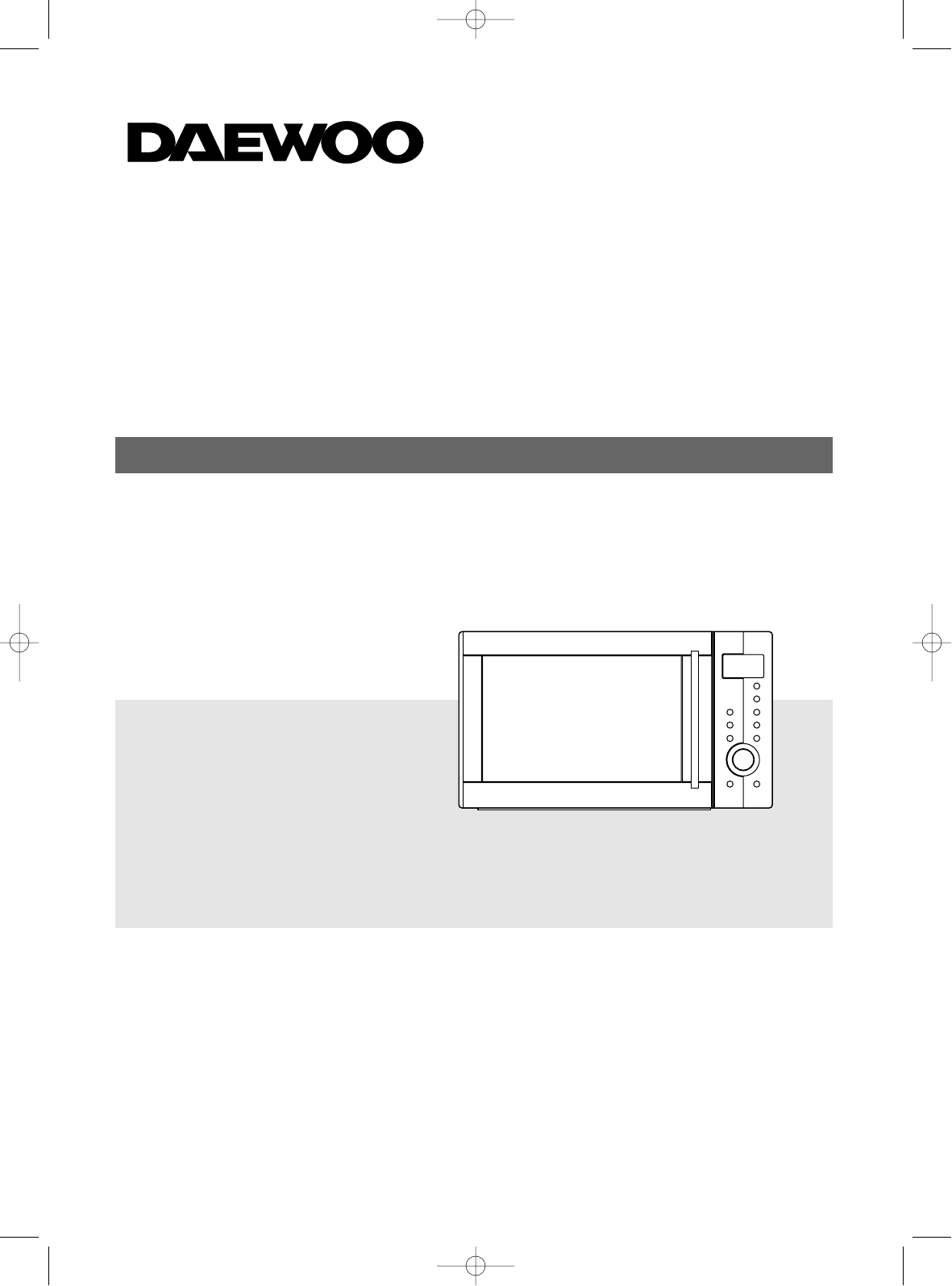
Before operating this oven, please read these manual completely.
OWNER’S
MANUAL
MICROWAVE
CONVECTION/GRILL OVEN
KOC-924T

1
TABLE OF CONTENTS
PRECAUTIONS TO AVOID POSSIBLE EXPOSURE TO
EXCESSIVE MICROWAVE ENERGY ................................................................................................................ 1
TABLE OF CONTENTS ..................................................................................................................................... 1
IMPORTANT SAFETY INSTRUCTION
FEDERAL COMMUNICATIONS COMMISSION RADIO FREQUENCY ............................................................ 2
INTERFERENCE STATEMENT ......................................................................................................................... 3
GROUNDING INSTRUCTIONS ......................................................................................................................... 3
INSTALLATION .................................................................................................................................................. 4
SPECIFICATIONS ............................................................................................................................................. 5
FEATURES DIAGRAM ....................................................................................................................................... 6
ACCRSSORIES ................................................................................................................................................. 7
BEFORE OPERATION ........................................................................................................................................8
SETTING THE CLOCK ........................................................................................................................................8
CHILD LOCK AND POWER SAVE MODE ..........................................................................................................9
OPERATION ......................................................................................................................................................10
MICROWAVE COOKING ..................................................................................................................................................10
GRILL COOKING...............................................................................................................................................................11
CONVECTION COOKING(with pre-heat)..........................................................................................................................12
CONVECTION COOKING (traditional cooking).................................................................................................................13
COMBINATION COOKING................................................................................................................................................14
WEIGHT DEFROST ..........................................................................................................................................................15
TIME DEFROST ................................................................................................................................................................15
AUTO COOK .....................................................................................................................................................................16
SPEEDY COOK.................................................................................................................................................................17
TO STOP THE OVEN WHILE THE OVEN IS OPERATING .............................................................................................17
ABNORMAL MESSAGES .................................................................................................................................17
GRNERAL GUIDELINES ..................................................................................................................................18
COOKING INSTRUCTION ............................................................................................................................... 19
COOKING UTENSILS ...................................................................................................................................... 19
MICROWAVE PRINCIPLES ............................................................................................................................ 20
HOW MICROWAVE COOK FOOD .................................................................................................................. 20
COOKING TECHNIQUES ................................................................................................................................21
DEFROSTING GUIDE ..................................................................................................................................... 22
DEFROSTING CHART .................................................................................................................................... 23
COOKING CHART ........................................................................................................................................... 24
REHEATING CHART ....................................................................................................................................... 25
CARE OF YOUR MICROWAVE OVEN ........................................................................................................... 27
USE YOUR MICROWAVE OVEN SAFELY...................................................................................................... 28
BEFORE YOU CALL FOR SERVICE ............................................................................................................... 29
QUESTIONS AND ANSWERS ......................................................................................................................... 29
PRECAUTIONS TO AVOID POSSIBLE EXPOSURE
TO EXCESSIVE MICROWAVE ENERGY
(a) Do not attempt to operate this oven with the door open since open-door operation can result in
harmful exposure to microwave energy. It is important not to defeat or tamper with the safety interlocks.
(b) Do not place any object between the oven front face and the door or allow soil or cleaner residue to
accumulate on sealing surfaces.
(c) Do not operate the oven if it is damaged. It is particularly important that the oven door close properly
and that there is no damage to the: (1) door (bent), (2) hinges and latches (broken or loosened), (3) door
seals and sealing surfaces.
(d) The oven should not be adjusted or repaired by anyone except properly qualified service personnel.

2
IMPORTANT SAFETY INSTRUCTIONS
SAVE THESE INSTRUCTIONS
When using electrical appliances, basic safety precautions should be followed, including the following:
WARNING-To reduce the risk of burns, electric shock, fire, injury to persons or exposure to excessive
microwave energy:
1. Read all instructions before using the appliance.
2. Read and follow the specific “PRECAUTIONS TO
AVOID POSSIBLE EXPOSURE TO EXCESSIVE
MICROWAVE ENERGY” found on page 1.
3. This appliance must be grounded. To ensure
continued protection against shock hazard, connect
only to properly grounded outlet.
See “GROUNDING INSTRUCTIONS” found on page
3.
4. Install or locate this appliance only in accordance with
the provided installation instructions.
5. Some products such as whole eggs and sealed
containers - for example, closed glass jars-may
explode and should not be heated in this oven.
6. Use this appliance only for its intended use as
described in this manual. Do not use corrosive
chemicals or vapors in this appliance. This type of
oven is specifically designed to heat, cook, or dry
food. It is not designed for industrial or laboratory
use.
7. As with any appliance, close supervision is necessary
when used by children.
8. Do not operate this appliance if it has a damaged
cord or plug, if it is not working properly, or if it has
been damaged or dropped.
9. This appliance should be serviced only by qualified
service personnel.
Contact nearest authorized service facility for
examination, repair or adjustment.
10. Do not cover or block any openings on the
appliance.
11. Do not store this appliance outdoors. Do not use this
product near water — for example, near a kitchen
sink, in a wet basement, or near a swimming pool,
and the like.
12. Do not immerse cord or plug in water.
13. Keep cord away from heated surfaces.
14. Do not let cord hang over edge of table or counter.
15. Either:
a) When cleaning surfaces of door and oven that
comes together on closing the door, use only
mild, non-abrasive soaps or detergents applied
with a sponge or soft cloth , or
b) When separate cleaning instructions are
provided, See door surface cleaning instructions
on (page.27).
16. To reduce the risk of fire in the oven cavity:
a) Do not overcook food. Carefully attend appliance
if paper, plastic, or other com-bustible materials
are placed inside the oven to facilitate cooking.
b) Remove wire twist-ties from paper or plastic
bags before placing bag in oven.
c) If materials inside the oven should ignite, keep
oven door closed, turn oven off, and disconnect
the power cord, or shut off power at the fuse or
circuit breaker panel.
d) Do not use the cavity for storage purposes. Do
not leave paper products, cooking utensils, or
food in the cavity when not in use.
17. Do not use this microwave oven to heat corrosive
chemicals (for example, sulfides and chlorides).
Vapours from such corrosive chemicals may
interact with the contact and springs of the safety
interlock switches thereby rendering them
inoperable.
18. Keep the waveguide cover clean at all times.
Wipe the oven interior with a soft damp cloth after
each use. If you leave grease or fat anywhere in
the cavity it may overheat, smoke or even catch fire
when next using the oven.
19. Never heat oil or fat for deep frying as you cannot
control the temperature and doing so may lead to
overheating and fire.
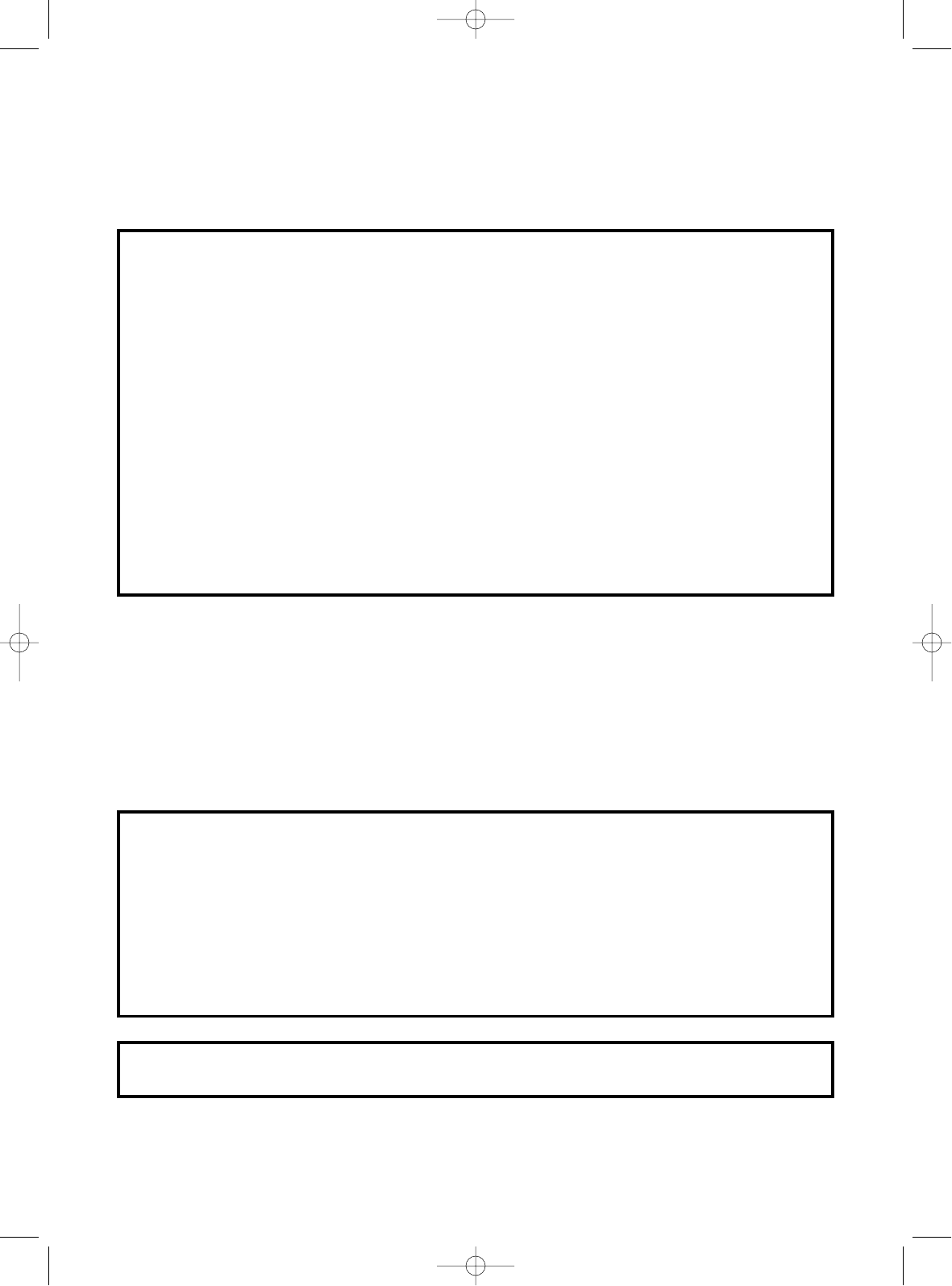
3
FEDERAL COMMUNICATIONS COMMISSION
RADIO FREQUENCY INTERFERENCE
STATEMENT
GROUNDING INSTRUCTIONS
This appliance must be grounded. In the event of an electrical short circuit, the grounding plug reduces the risk
of electric shock by providing an escape wire for electric current. This appliance is equipped with a cord having
a grounding wire with a grounding plug. The plug must be plugged into an outlet that is properly installed and
grounded.
WARNING:
This equipment generates and uses ISM frequency energy and if not installed and used properly, that is in
strict accordance with the manufacturer's instructions, may cause interference to radio and television
reception.
It has been type-tested and found to comply with limits for an ISM Equipment pursuant to part 18 of FCC
Rules, which are designed to provide reasonable protection against such interference in a residential
installation.
However, there is no guarantee that interference will not occur in a particular installation.
If this equipment does cause interference to radio or television reception, which can be determined by
turning the equipment off and on, the user is encouraged to try to correct the interference by one or more
of the followings.
• Reorient the receiving antenna of radio or television.
• Relocate the Microwave oven with respect to the receiver.
• Move the microwave oven away from the receiver.
• Plug the microwave oven into a different outlet so that microwave oven and receiver are on
different branch circuits.
THE MANUFACTURER is not responsible for any radio or TV interference caused by
UNAUTHORIZED MODIFICATION to this microwave oven. It is the responsibility of
the user to correct such interference.
WARNING:
Improper use of the grounding can result in a risk of electric shock.
Consult a qualified electrician or serviceman if the grounding instructions are not completely understood,
or if doubt exists as to whether the appliance is properly grounded, and either :
(1) If it is necessary to use an extension cord, use only a 3-wire extension cord that has a 3-blade
grounding plug, and a 3-slot receptacle that will accept the plug on the appliance. The marked
rating of the extension cord shall be equal to or greater than the electrical rating of the appliance.
or
(2) Do not use an extension cord, if the power supply cord is too short, have a qualified electrician or
serviceman install an outlet near the appliance.
WARNING:
Do not cut or remove the third (ground) prong from the power cord under any circumstances.
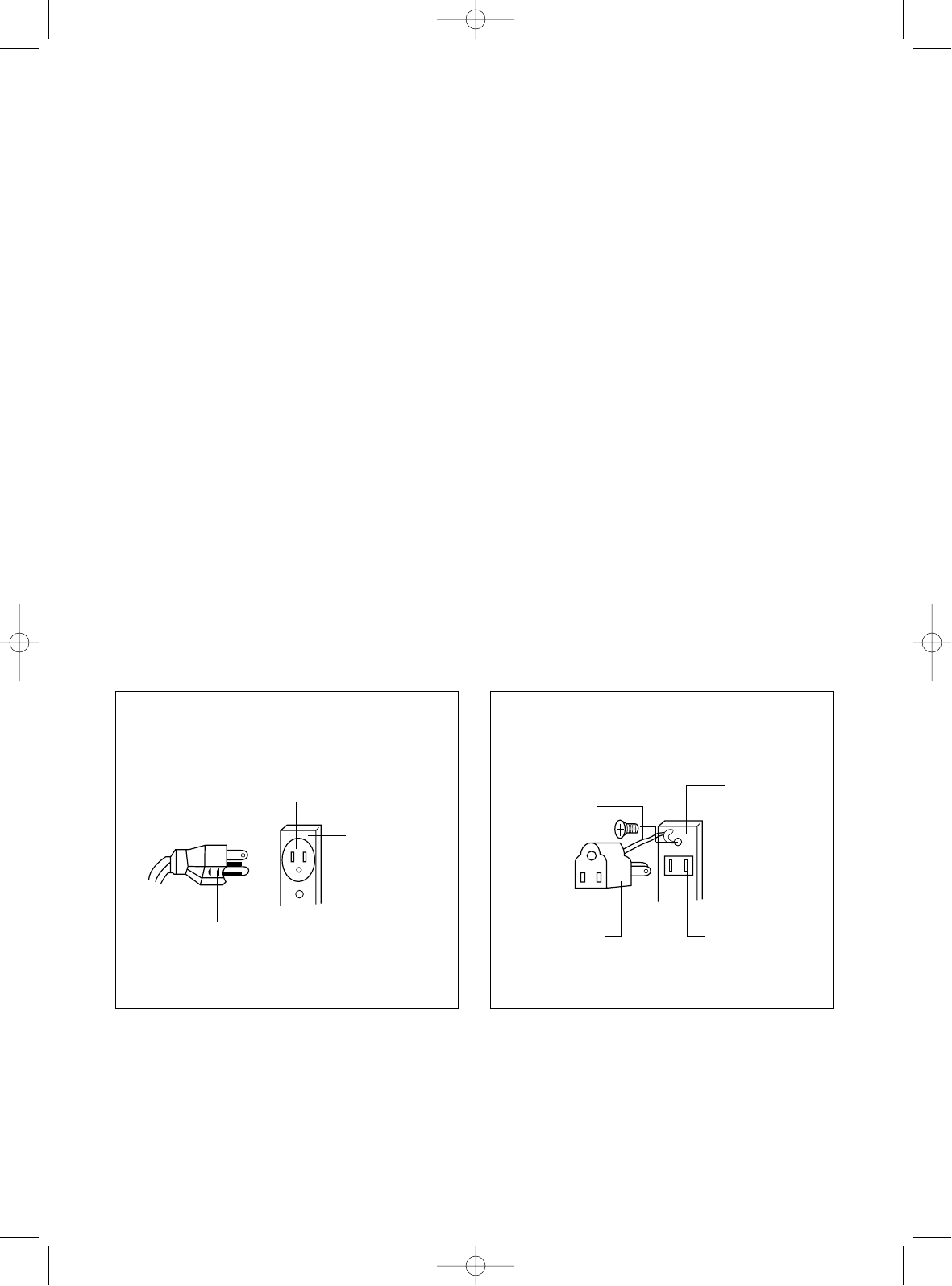
4
INSTALLATION
1Examine the oven after unpacking. Check for damage such as a misaligned door, broken door or dent in
the cavity.
If any damage is visible, DO NOT INSTALL, and notify your dealer immediately.
2Level, flat location. Install the microwave oven on a level, flat surface, and more than 3ft(914mm) above the floor.
3Ventilation. Do not block air vents. If they are blocked during operation, the oven may overheat and
eventually cause a failure. For proper ventilation, allow 4 inches of space between oven top, sides, rear and
adjacent surfaces.
4Away from radio and TV sets. Poor television reception and radio interference may result if the oven is
located close to a TV, radio, antenna, feeder, etc. Place the oven as far from them as possible.
5Away from heating appliances and water taps. Keep the oven away from heat, steam or splashing
liquids. These things can adversely affect oven wiring and contacts.
6Power supply. This microwave oven requires a power supply of approximately 13 Amperes, 120 Volts,
60Hz and a grounded outlet. A short power cord is provided to reduce the risk of the user becoming
entangled in or tripping over a longer cord. Longer cord sets or extension cords are available and may be
used if care is exercised in their use.
If an extension cord is used, the marked electrical rating of the cord should be at least as great as the
electrical rating of the oven.
The extension cord must be a grounding-type 3-wire cord. The longer cord should be arranged so that it will
not drape over the table top or counter where it can be pulled on by children or tripped over unintentionally.
7The minimum height of free space necessary above the top surface of the oven is 4inch.
When use 3-pronged plug When use grounding adaptor, make sure
the receptacle box is fully grounded.
3-prong Receptacle
Receptacle
Box cover
3-prong plug
Grounding
Lead
Grounding
Adapter Receptacle
“THE CANADIAN ELECTRICAL CODE DOES NOT ALLOW THE USE OF THE GROUNDING ADAPTOR”
Receptacle
Box Cover
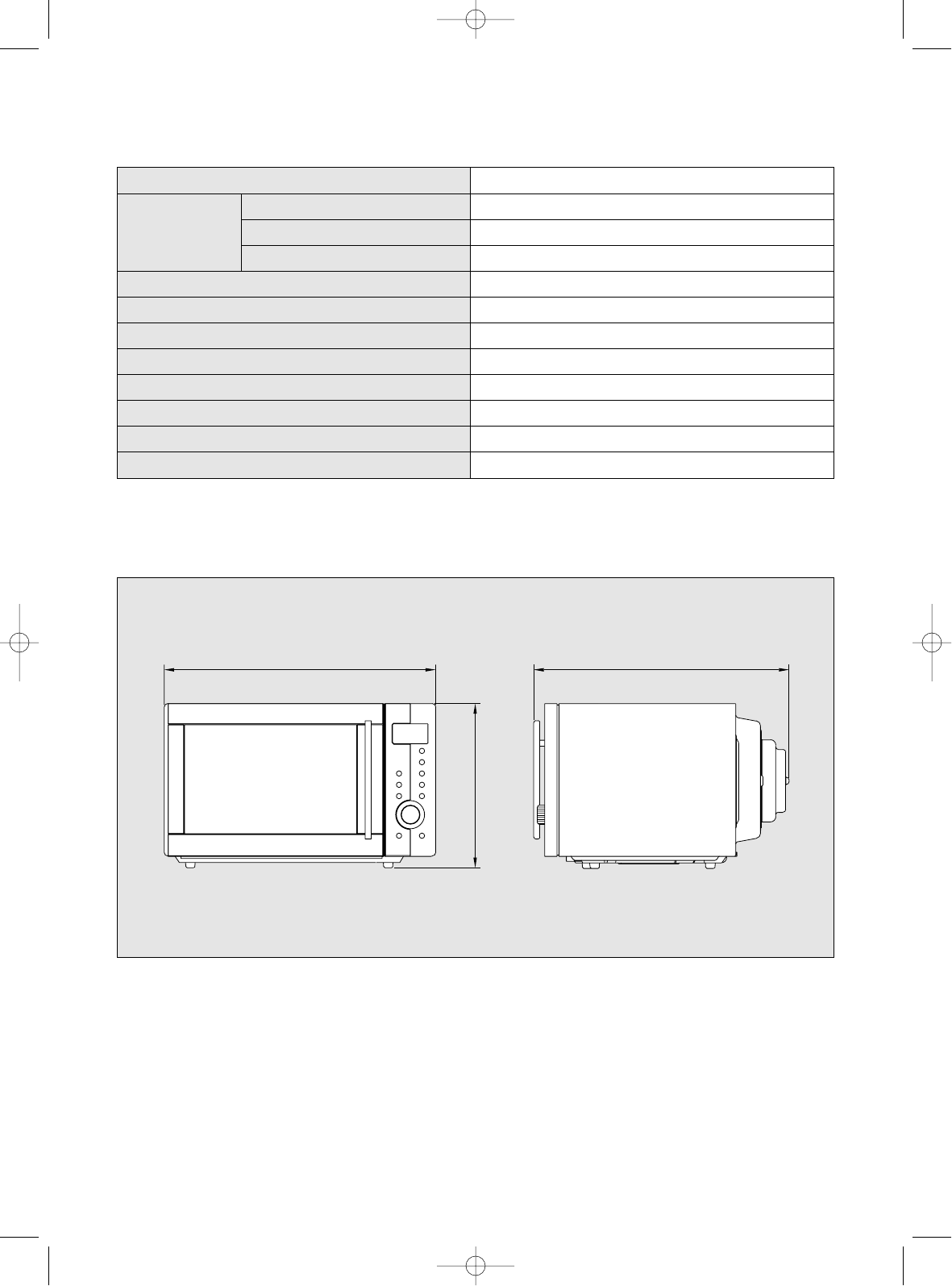
5
SPECIFICATIONS
POWER SUPPLY
120V AC 60 Hz SINGLE PHASE WITH GROUNDING
POWER CONSUMPTION 1500W
MICROWAVE OUTPUT POWER 1000W
FREQUENCY 2450 MHZ
GRILL POWER CONSUMPTION 850W
CONVECTION POWR CONSUMPTION 1450W
COMBINATION HEATING POWER CONSWMPTION 1500W
OUTSIDE DIMENSIONS (WXHXD) 542 x 329 x 515 mm ( 21.3 x 13.0 x 20.3 in. )
CAVITY DIMENSIONS (WXHXD) 350 x 230 x 355 mm ( 13.8 x 9.1 x 14.0 in. )
NET WEIGHT APPROX. 20 Kg ( 44.1 lbs. )
TIMER 60 min.
POWER SELECTIONS 10 LEVELS
* Specifications are subject to change without notice.
542
329
515
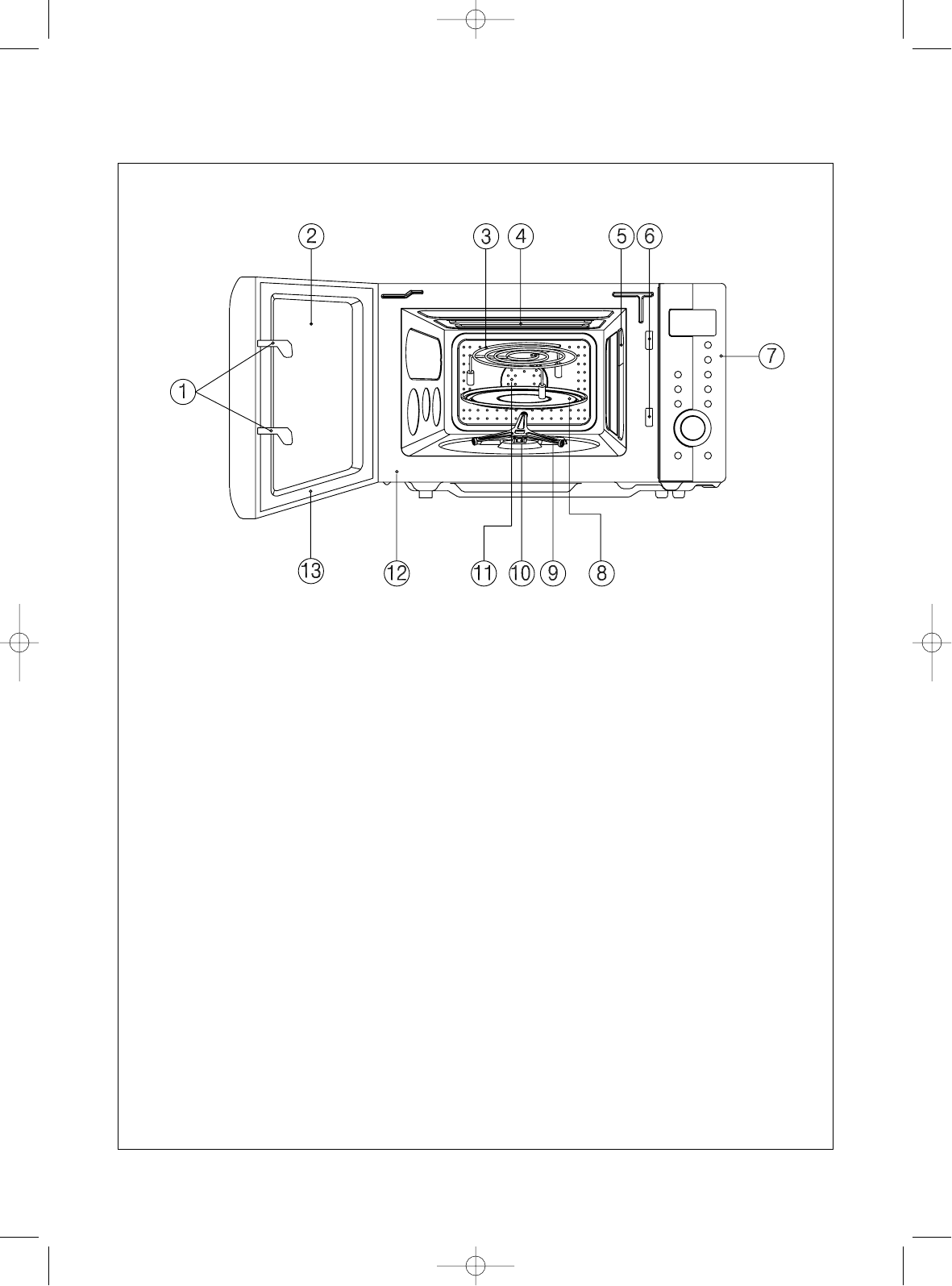
6
FEATURES DIAGRAM
1DOOR HOOK - When the door is closed, it will automatically lock shut. If door is opened while oven
is operating, the magnetron will immediately stop operating.
2DOOR VIEWING SCREEN - Allows viewing of food. The screen is designed so that light can pass
through, but not the microwave.
3METAL RACK
4TOP HEATER - Turns on when convection, grill and combi cooking is selected.
5OVEN LAMP - Automatically turns on during oven operating.
6SAFETY INTERLOCK SYSTEM
7CONTROL PANEL
8TURNTABLE TRAY - Rotates during cooking and ensure even distribution of Microwaves.
It can also be used as a cooking utensil.
9ROLLER GUIDE - This must always be used for cooking together with the turntable tray.
0COUPLER - This fits over the shaft in the center of the ovens cavity floor. This is to remain in the
oven for all cooking.
qCONVECTION OUTLET & FAN
wOVEN FRONT PLATE
eDOOR SEAL - Door seal maintains the microwave energy within the oven cavity and prevents
microwave leakage.
rBARBECUE BAR (KOC-924T0S01/KOC-924T5S01)-Not seen.
This is used barbecue cooking.
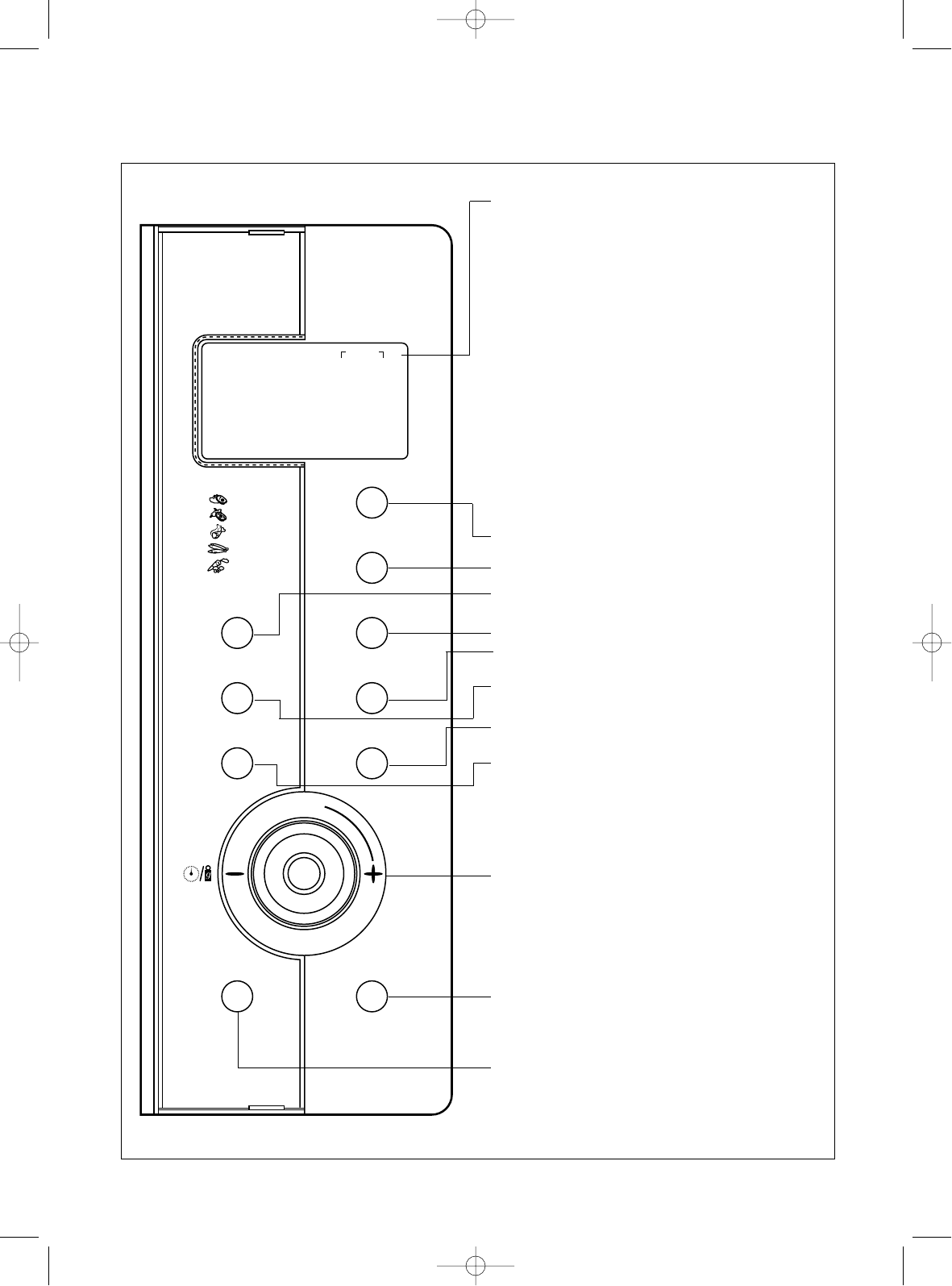
7
FEATURES DIAGRAM (continued)
T
i
m
e
/
W
e
i
g
h
t
Q
u
a
n
t
i
t
y
Auto cook
MW Grill Combi Weight Time
Auto
Cook Lock Con-
vection lb
Defrost
Combi
Grill
MW
Convection
START /
SPEEDY COOK
Weight
Defrost
Auto Cook Menu
1. Roast pork
2. Roast beef
3. Roast chicken
4. Baked fish
5. Fresh vegetable
Time
Defrost
Clock
STOP/CLEAR
11
Display : Cooking time, power level, indicators and
present time are displayed.
MW : When blinking, the oven is operating in
MICROWAVE COOK.
Grill : When blinking, the oven is operating in GRILL.
Combi : When blinking, the oven is operating in
COMBI.
Defrost Weight : When blinking, the oven is operating
in WEIGHT DEFROST.
Time : When blinking, the oven is operating in TIME
DEFROST.
Auto-cook : When blinking, the oven is operating
AUTO COOK.
Lock : When lighting, the oven is CHILD LOCK.
Con-vection : When blinking, the oven is operating in
CONVECTION.
lb : When blinking, the oven is operating in weight
input mode.
22
Auto cook : Used to cook or reheat.
33
Combi : Used to select combi.
44
Weight Defrost : Used to defrost foods.
55
Grill : Used to select grill.
66
MW : Used to set power level of micro wave.
77
Time Defrost : Used to defrost foods.
88
Convection : Used to select convection and selected
temp.
99
Clock : Used to set clock.
00
Dial knob : Used to set time, weight and quantity.
qq
START/SPEEDY COOK : Used to start a programmed,
also for speedy start(each press adds 30 seconds
microwave cooking time).
ww
STOP/CLEAR : Used to stop the oven operation or to
delete the cooking data.
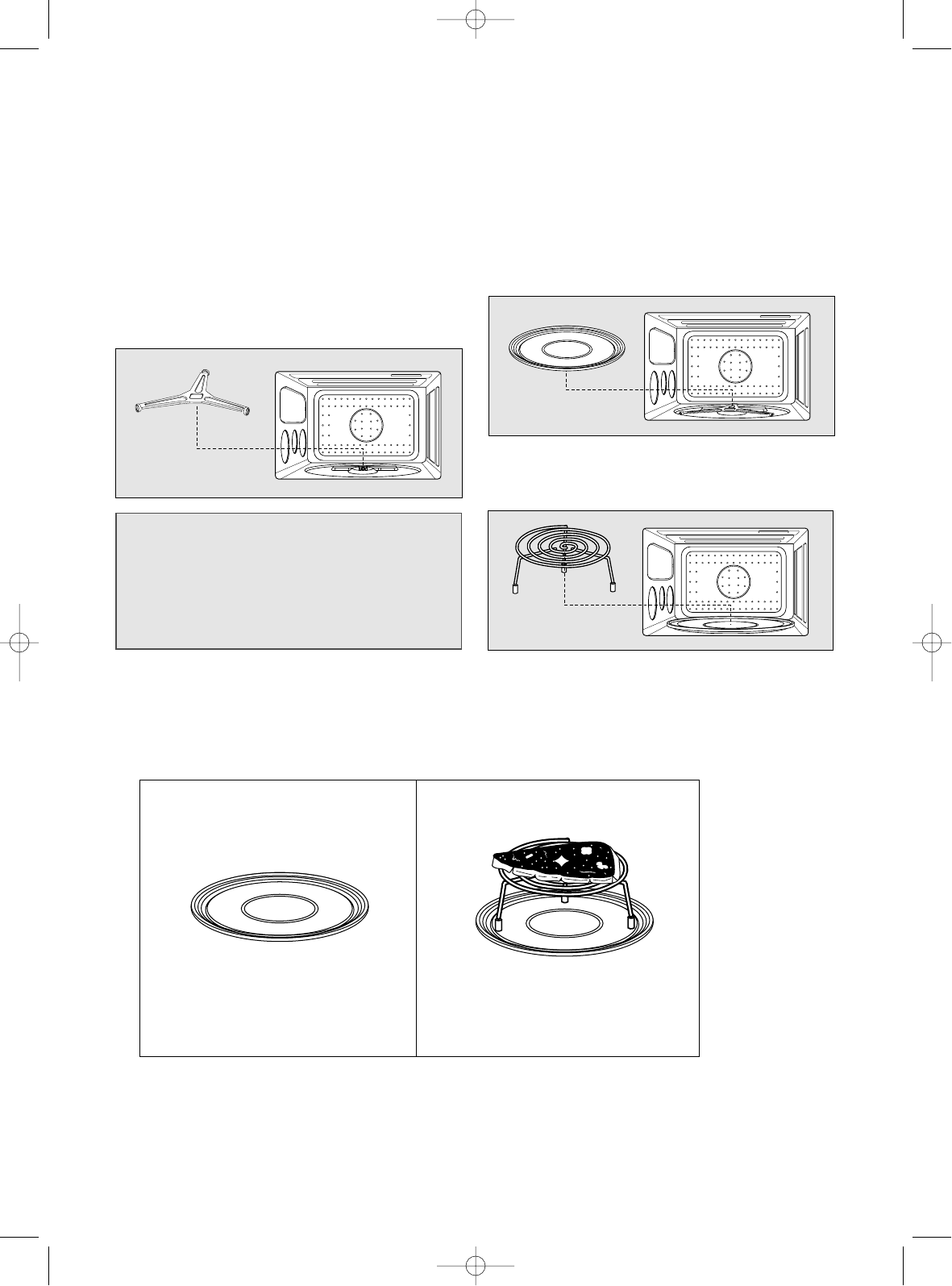
8
ACCESSORIES
This oven comes equipped with several accessories.
They can be used in various ways to facilitate cooking.
■Rotating base
This fits over the shaft in the center of the oven’s cavity
floor.
This to remain in the oven for all cooking. It should only be
removed for cleaning.
■Turntable tray or turntable
This metal tray fits over the rotating base and locks into
place.
This is to be used in the oven for all cooking. It rotates
clockwise or counterclockwise during cooking. It is easily
removable for cooking and cleaning needs.
■Metal rack
This metal rack is used with the turntable tray.
■HOW TO USE THE ACCESSORIES OF COOKING
Important:
The rotating base must be placed in the center of
the oven’s cavity and fitted in the rotating shaft
exactly.
In case the rotating base does not fit in the
rotating shaft, the rotating base might become as
tray and sparks can occur.
■Turntable
• Microwave cooking
• Convection cooking
• Combination cooking
• Auto cooking
■Metal rack
• Grill cooking
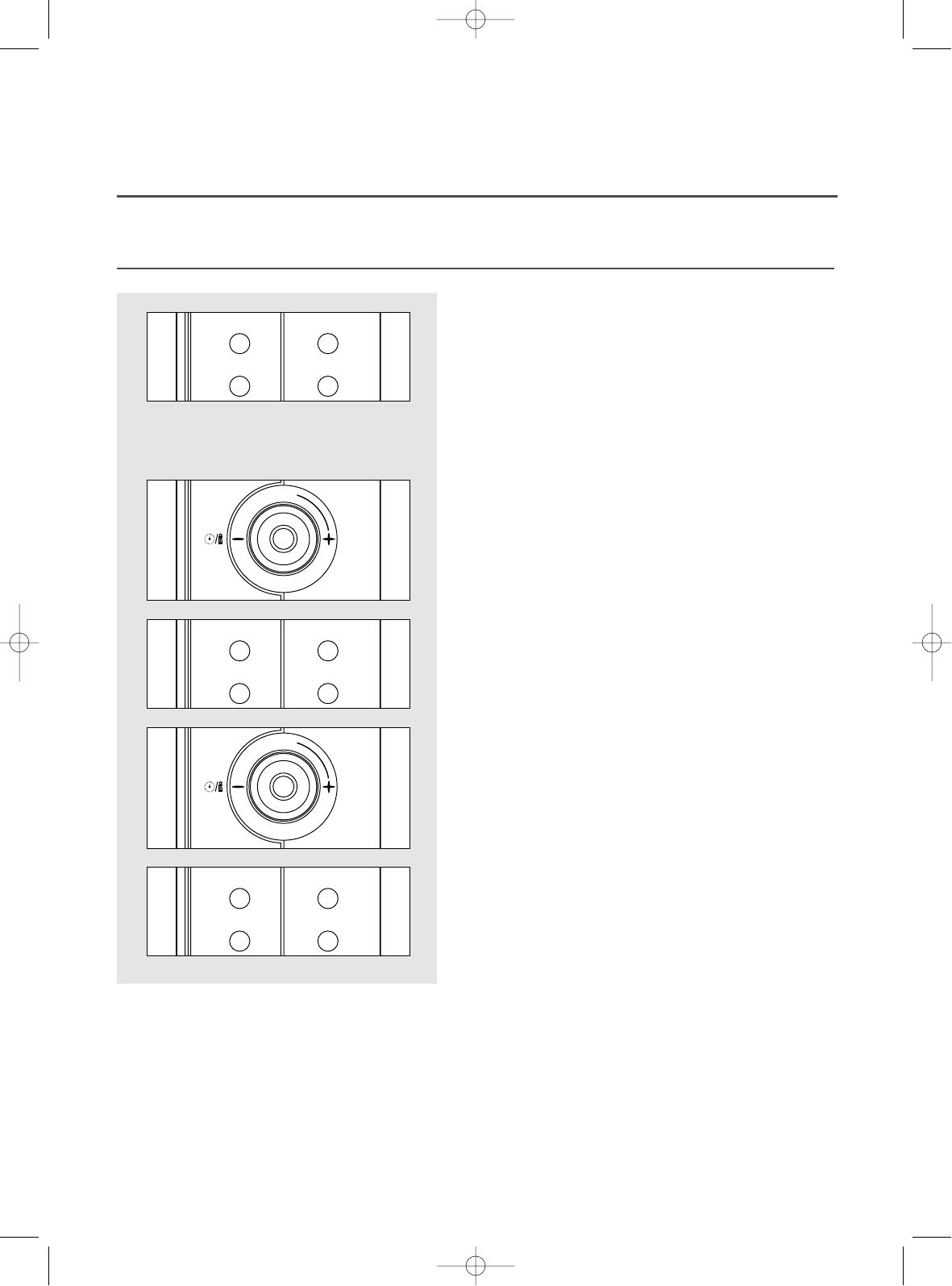
9
BEFORE OPERATION
When your oven is plugged in, the display will flash “ :0” and a tone will sound. If the AC power ever goes off, the
display shows “ :0” when the power comes back on.
Your oven has multiple(12hr/24hr) clock system. To set the clock follow under procedure.
Example : To set 5:30
1. Press Clock button once. (example : to set " 5:30 ")
The display will be " 12H " shows.
2. Press Clock button once more, " 24H " shows in display.
This is a 24hour clock system. If you want 12hour clock
system, omit this step.
3. Turn the dial knob to set the hour number " 5: ".
The hour number starts blinking, the colon will right.
4. Press Clock button. " 5:00 " shows in display.
The minute number starts blinking, the colon and hour
number will light.
5. Turn the dial knob until " 5:30 " in the display window.
6. Press Clock button. The colon starts blinking.
If you selected 12hour clock system, this digital clock
allows you to set from 1:00 to 12:59.
If you selected 24hour clock system, this digital clock
allows you to set from 0:00 to 23:59.
SETTING THE CLOCK
MW
Convection
Time
Defrost
Clock
▲
T
i
m
e
/
W
e
i
g
h
t
Q
u
a
n
t
i
t
y
START /STOP/CLEAR
MW
Convection
Time
Defrost
Clock
▲
✭✷
✣❏■❖❅❃▼❉❏■
✴❉❍❅
✤❅❆❒❏▲▼
✣●❏❃❋
▲
✴
❉
❍
❅
✏
✷
❅
❉
❇
❈
▼
✱
◆
❁
■
▼
❉
▼
❙
✳✴✡✲✴ ✏✳✴✯✰✏✣✬✥✡✲
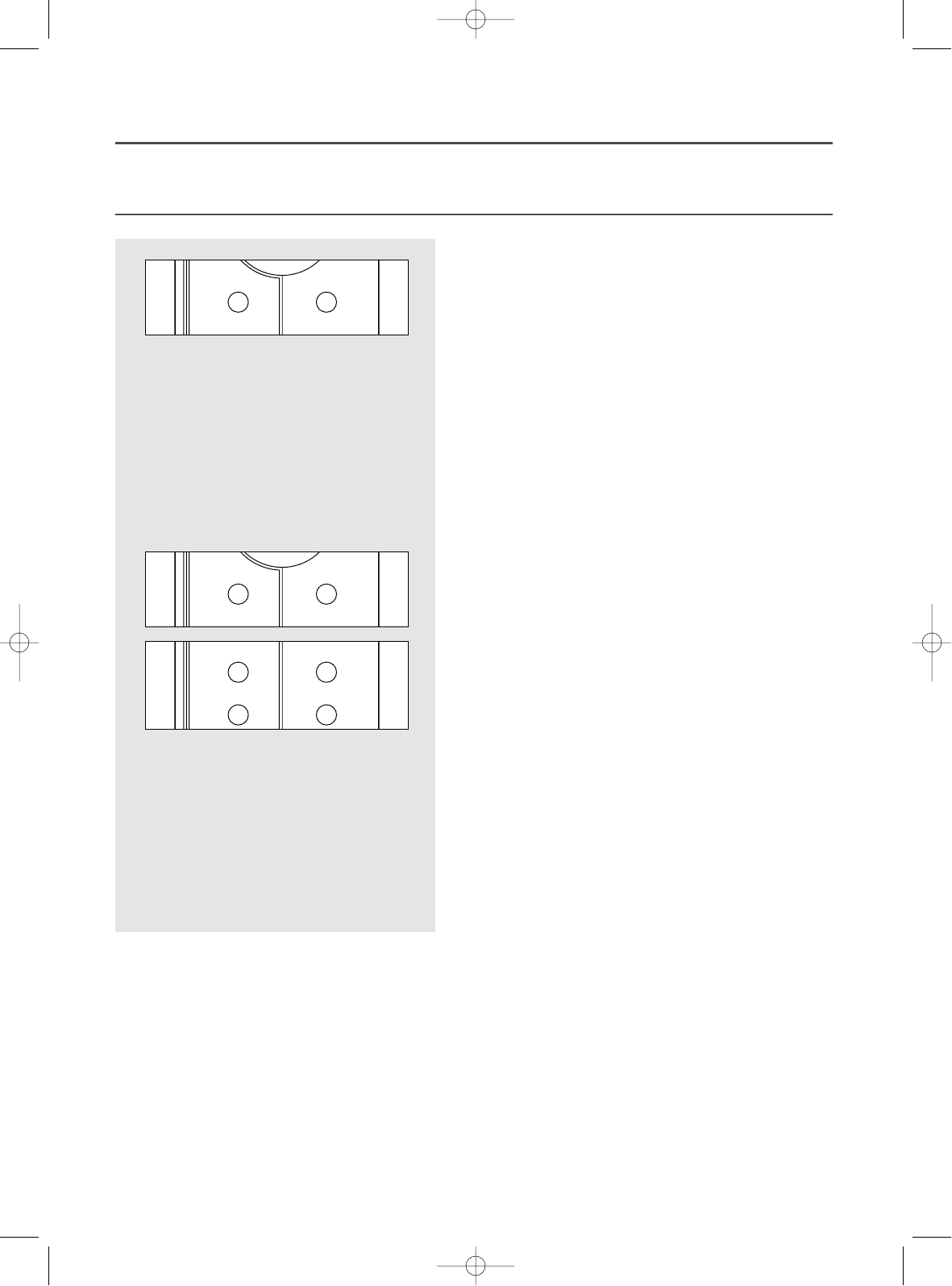
10
Child lock : The child lock prevents the oven from being used. For example because children could hurt
themselves on hot liquids etc.
Power save mode : This function is used for saving energy.
To set child lock
1. Press STOP/CLEAR button.
" : 0" or clock appears in the display.
2. Press and then hold STOP/CLEAR button for 3 seconds.
The oven will lock indicator lights.
Now the oven cannot be operated.
3. To cancel child lock simply repeat procedure 2.
The oven will beep and lock indicator disappears.
The oven is again available for normal use.
To set power save mode
1. Press STOP/CLEAR button.
" : 0" or clock appears in the display.
2. Press and then hold Clock button for 3 seconds.
The display will turn off and a beep sounds.
To operate the oven in power save mode, press any key
or turn the knob.
Then " :0" or clock will be shown and the operation of all
function key will be same as in the normal mode.
But if there is no operation within 10 seconds in clear
mode or while manipulating the key, all the contents of
display will disappear.
3. To cancel power save simply repeat setting procedure.
When the display is on.
The power save mode will be canceled and a beep
sounds.
The oven is again available for normal use.
CHILD LOCK AND POWER SAVE MODE
START / SPEEDY COOKSTOP/CLEAR
▲
START / SPEEDY COOKSTOP/CLEAR
MW
Convection
Time
Defrost
Clock
▲▲
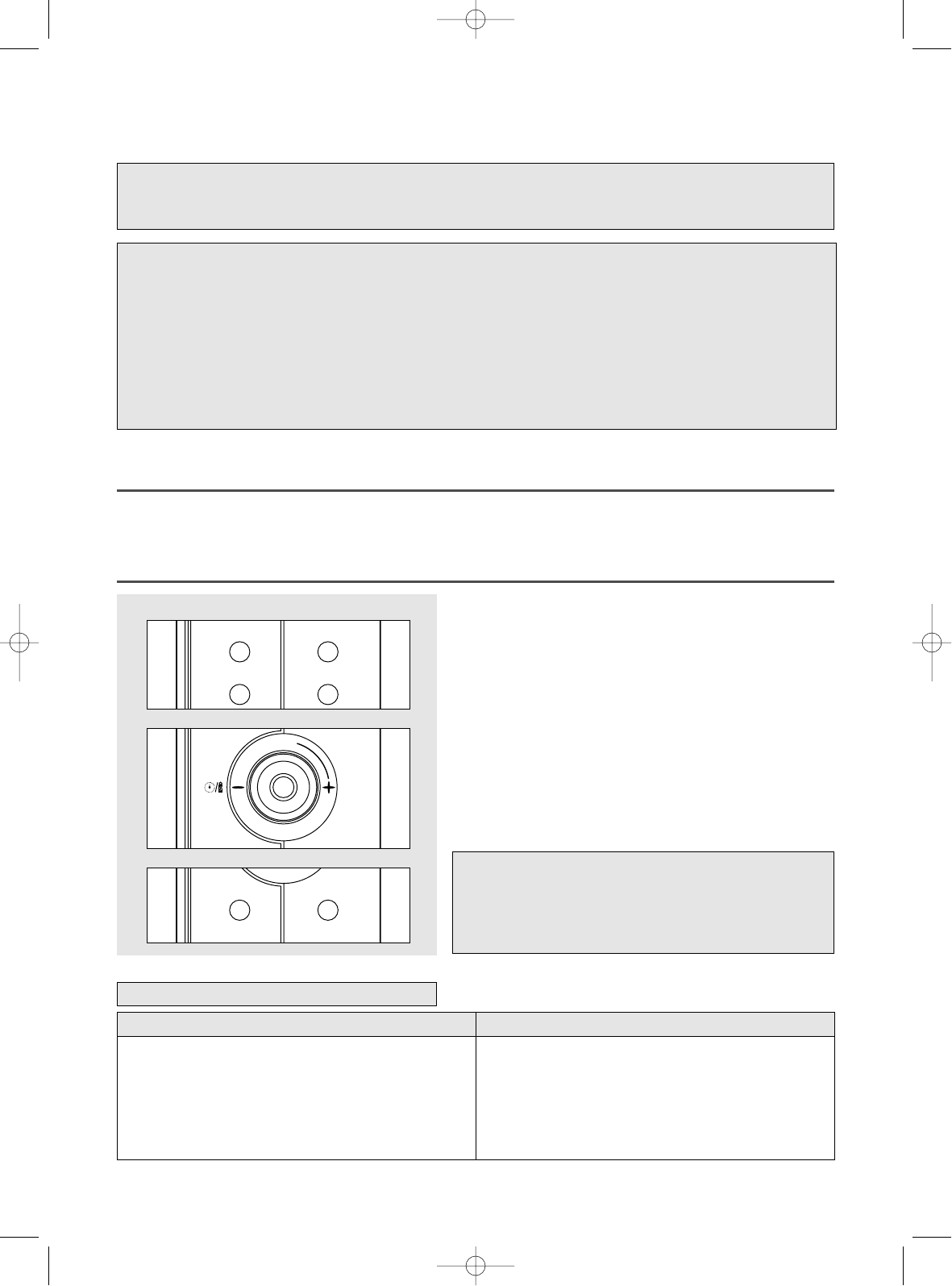
11
Tips : Also remember to read this operating instruction for proper safety information and instruction before
using the oven. Prior to setting the controls, place one cup of water in the oven, on a heat-proof glass
measuring cup, for testing purposes.
Note : When the operation is finished the oven beeps three times, " : 0" or clock appears in the display, the rotating
plate stops turning and the oven light turns off. The oven will continue to beep every 1 minute until the
STOP/CLEAR button is pressed, or the door is opened.
The cooling fan continues to run for 5 minutes after cooking has stopped when it takes over 3 minutes for
cooking.( the display will show "COOL" and " :0 or clock" ) Opening the oven door interrupts any operation
except cooling fan.To cancel the operation, press STOP/CLEAR button. To continue the operation, press
START/SPEEDY COOK button. The oven displays the set cooking time in 10 seconds steps( up to 5
minutes cooking time ), in 30 seconds steps( up to 10 minutes cooking time ), in 1 minutes steps( up to 60
minutes cooking time ).
Power level table
OPERATION
This microwave cooking method allows you to cook food for a desired time. In addition to the maximum power
level(100%), you can select different microwave power from 9 other levels, 10% to 90% for the foods that require slower
cooking. If you have used the appliance for grilling, convection or combination cooking, let the oven cool down before
using again. Never switch the microwave oven on when it is empty.
MICROWAVE COOKING
1. Press MW button once. MW indicator lights.
" P-HI " shows in display.
2. Select the appropriate power level by pressing the MW button
again until the corresponding percentage is displayed. Refer
to the power level table below for further details.
3. Turn the dial knob to set the cooking time.
For a cooking time of 5 minutes 30 seconds, turn the dial
knob to the right to set 5:30. ( up to 60 minutes )
" 5:30" shows in display.
4. Press START/SPEEDY COOK button.
The oven light comes on and the turntable starts rotating.
Cooking starts and the time in the display will count down.
MW
Convection
Time
Defrost
Clock
▲
✳✴✡✲✴ ✏ ✳✰✥✥✤✹ ✣✯✯✫✳✴✯✰✏✣✬✥✡✲
▲
✴
❉
❍
❅
✏
✷
❅
❉
❇
❈
▼
✱
◆
❁
■
▼
❉
▼
❙
✳✴✡✲✴ ✏✳✴✯✰✏✣✬✥✡✲
✰❏◗❅❒ ●❅❖❅●
P-HI
P-90
P-80
P-70
P-60
percentage
100%
90%
80%
70%
60%
Output
1000W
900W
800W
700W
600W
Power level
P-50
P-40
P-30
P-20
P-10
P-00
percentage
50%
40%
30%
20%
10%
0%
Output
500W
400W
300W
200W
100W
0W
Note : The oven will automatically work on 100% microwave
power if a cooking time is entered without the power level
previously being selected.You can check the power level
while cooking is in progress by pressing the MW button. The
display will show the current power level for 3 seconds.
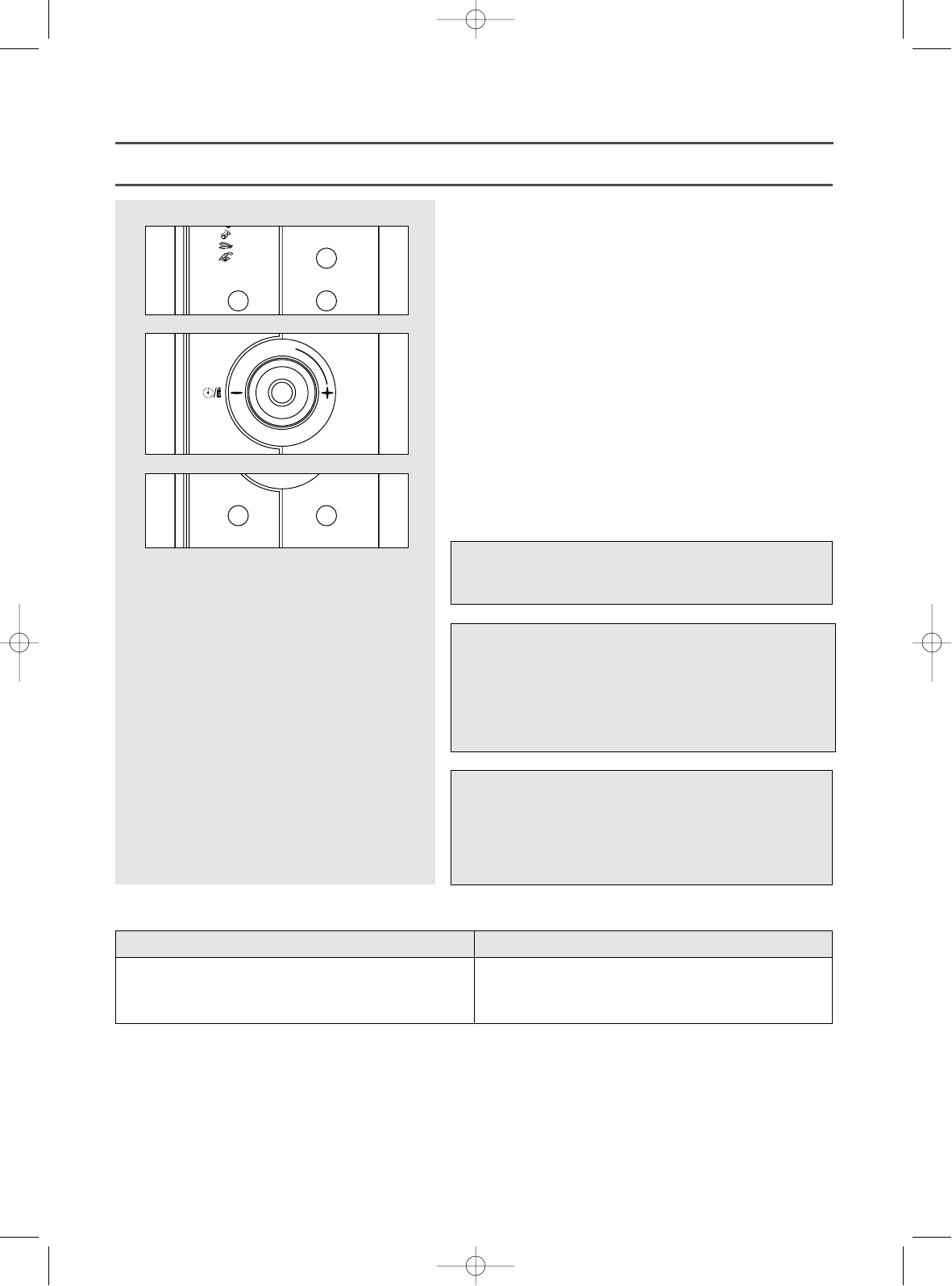
12
The grill enables you to heat and brown food quickly, without using microwaves.
GRILL COOKING
Note : When first using the grill heaters, smoke and odour
will be given off. To avoid this happening when food
is being cooked, heat the upper and lower grills
without food for approximately 10 minutes.
Place food directly on the rack, in a flan dish or on a
heat resistant plate on the rack.
Note :
The heating element is located in the top of the oven.
1. Press Grill button once. GRILL(upper grill) indicator lights.
2. Turn the dial knob to set the grilling time.
For a grilling time of 11 minutes, turn the dial knob to the
right to set 11:00.( up to 60 minutes )
“11:00” shows in display.
3. Press START/SPEEDY COOK button.
The oven light comes on and the turntable starts rotating.
Cooking starts and the time in the display will count down.
Combi
Grill
Weight
Defrost
3. Roast chicken
4. Baked fish
5. Fresh vegetable
▲
✳✴✡✲✴ ✏ ✳✰✥✥✤✹ ✣✯✯✫✳✴✯✰✏✣✬✥✡✲
✴
❉
❍
❅
✏
✷
❅
❉
❇
❈
▼
✱
◆
❁
■
▼
❉
▼
❙
✳✴✡✲✴ ✏✳✴✯✰✏✣✬✥✡✲
✷✡✲✮✩✮✧ ✚
The temperature inside the oven and window is very high.
Do not touch the oven window and metallic interior of the
oven when taking food in and out.
Use thick oven gloves while handling food or accessories.
▲
Suggested use
This method is ideal for toasting bread or muffins.
Remember the oven will be hot.
Place all food on metal rack.
Cookware
Use oven-proof cookware.
As there is no microwave energy being used you can
place metal tins directly onto the metal rack with no
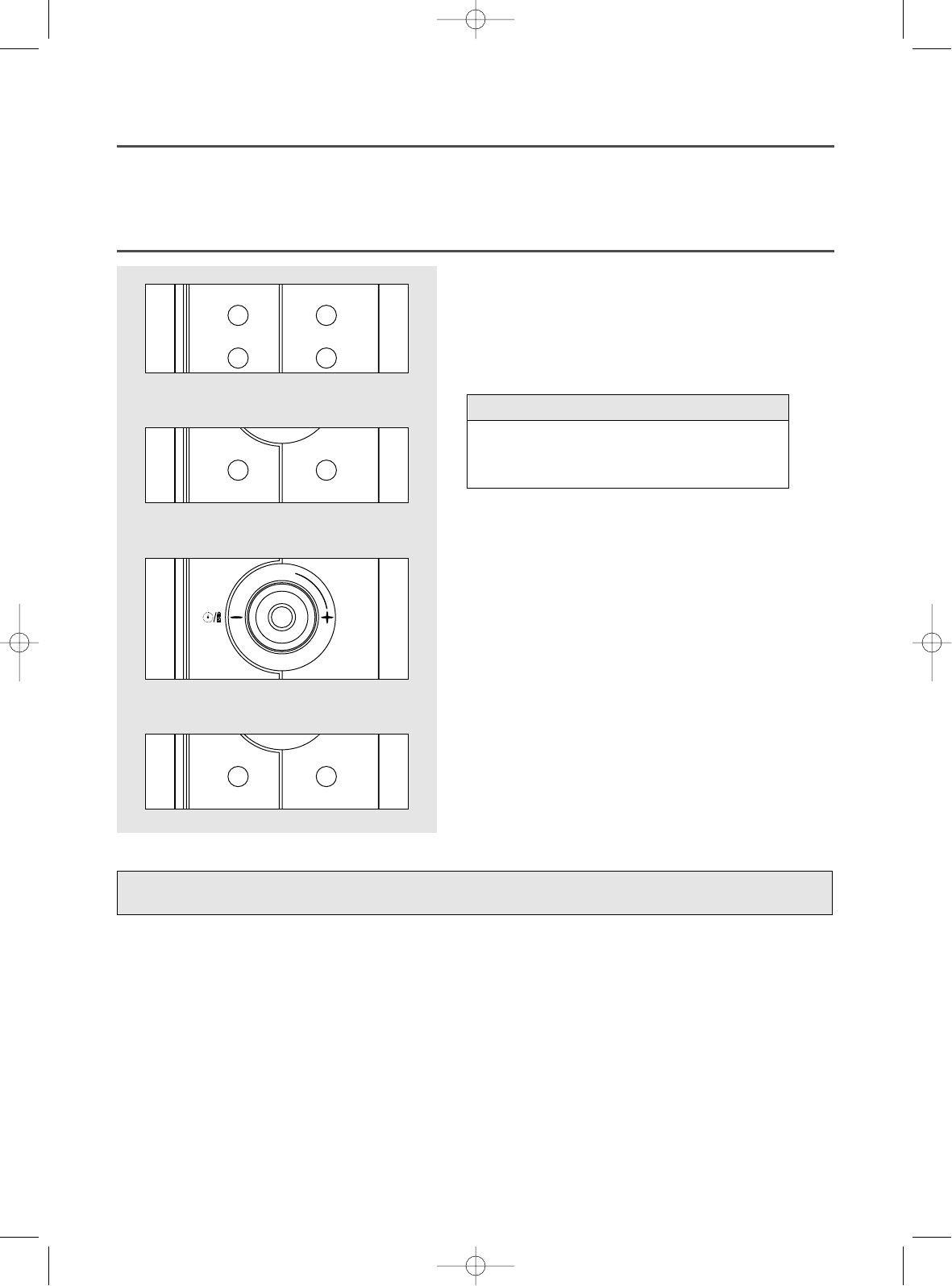
13
For convection cooking, it is recommended that you preheat the oven to the appropriate temperature before placing the
food in the oven.
The maximum preheating time is 30 minutes. If the cooking is not started immediately after preheating, the convection
indicator will continue to flash and the preheated oven temperature will be displayed.
It is maintained for 15 minutes; it is then switched off automatically.
CONVECTION COOKING(with pre-heat)
1. Press Convection button once. CONVECTION indicator
lights.
“110C” shows in display.
2. Select the convection cooking temperature by pressing the
Convection button again until the corresponding
temperature is displayed.
3. Press START/SPEEDY COOK button. CONVECTION
indicator blinks.
Temperature of preheating and “PrE-” blink altematively in
the display.
The oven will now preheat. When oven is preheated the
oven will beep and the preheated oven temperature will
appear in the display.
Then open the door and place your food in the oven.
Oven temperature and shows in display.
4. Turn the dial knob to set the cooking time.
For a cooking time of 11 minutes, turn the dial knob to the
right to set 11:00.(up to 60 minutes)
“11:00” shows in display.
5. Press START/SPEEDY COOK button.
The oven light comes on and the turntable starts rotating.
Cooking starts and the time in the display will count down.
MW
Convection
Time
Defrost
Clock
▲
START / SPEEDY COOKSTOP/CLEAR
T
i
m
e
/
W
e
i
g
h
t
Q
u
a
n
t
i
t
y
START /STOP/CLEAR
Temperature sequence
110C → 120C → 130C → 140C → 150C →
160C → 170C → 180C → 190C → 200C →
210C → 220C → 230C → 240C → 250C →
Note: You can check the setting temperature while preheating is in progress by pressing the Convection button.
▲
✳✴✡✲✴ ✏ ✳✰✥✥✤✹ ✣✯✯✫✳✴✯✰✏✣✬✥✡✲
▲
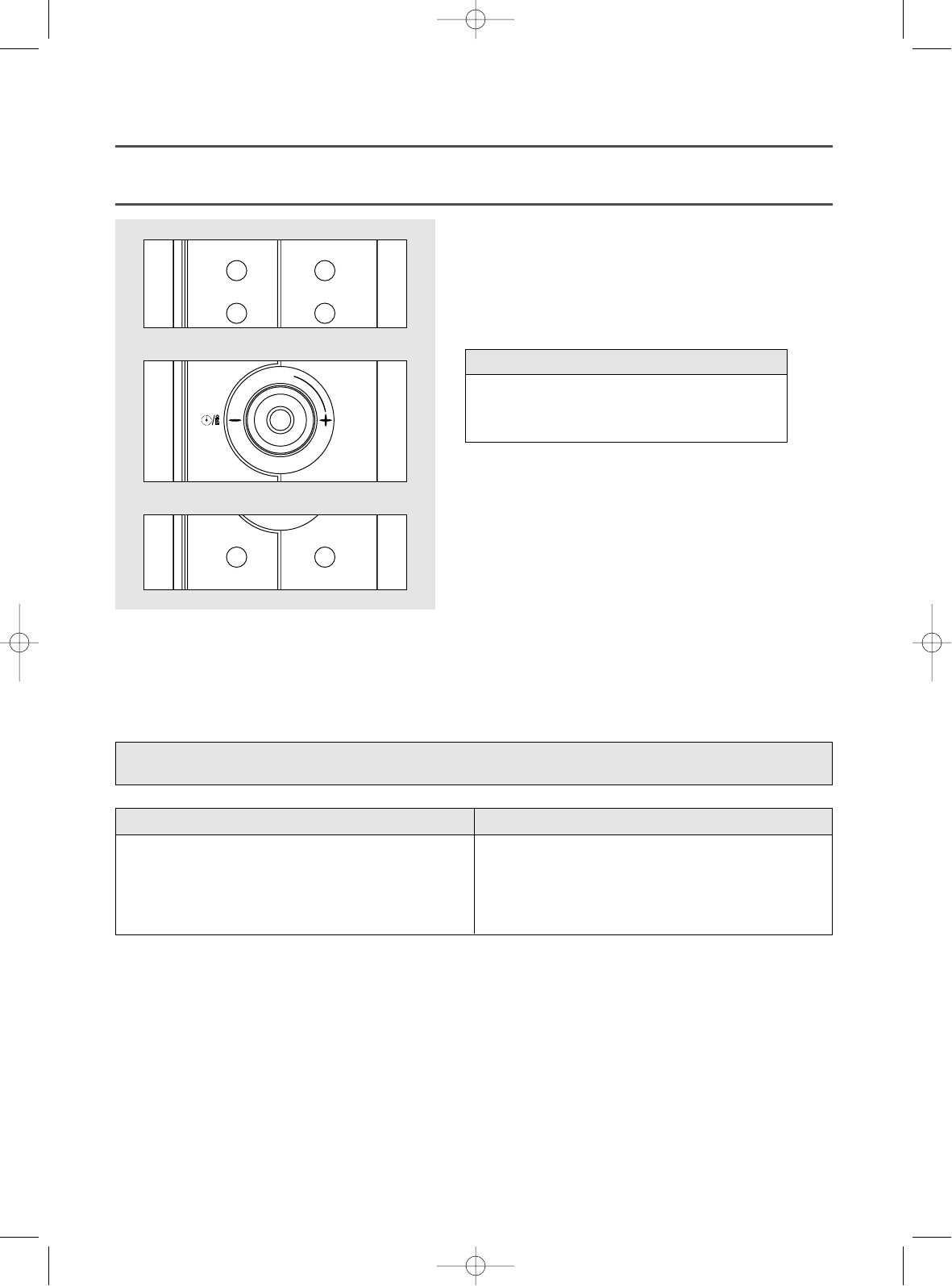
14
The convection mode enables you to cook food in the same way as in a traditional oven. Microwaves are not used.
Always use oven gloves when touching the recipients in the oven, as they will be very hot.
CONVECTION COOKING(traditional cooking)
1. Press Convection button once. CONVECTION indicator
lights.
“110C”shows in display.
2. Select the convection cooking temperature by pressing the
Convection button again until the corresponding
temperature is displayed.
3. Turn the dial knob to set the cooking time.
For a cooking time of 11 minutes, turn the dial knob to the
right to set 11:00.(up to 60 minutes)
“11:00”shows in display.
4. Press START/SPEEDY COOK button.
The oven light comes on and the turntable starts rotating.
Cooking starts and the time in the display will count down.
MW
Convection
Time
Defrost
Clock
▲
T
i
m
e
/
W
e
i
g
h
t
Q
u
a
n
t
i
t
y
START /STOP/CLEAR
START / SPEEDY COOKSTOP/CLEAR
Temperature sequence
110C → 120C → 130C → 140C → 150C →
160C → 170C → 180C → 190C → 200C →
210C → 220C → 230C → 240C → 250C →
Note: You can check the setting temperature while cooking is in progress by pressing the Convection button.
▲
Suggested use
This function is ideal for cooking meringues, cookies,
biscuits, scones, bread, puddings, large fruit cakes
and all pastries.
Remember the oven will be hot.
Place all food on metal rack.
Cookware
Use oven-proof cookware.
As there is no microwave energy being used you
can place metal tins directly onto the metal rack with
no danger of arcing.
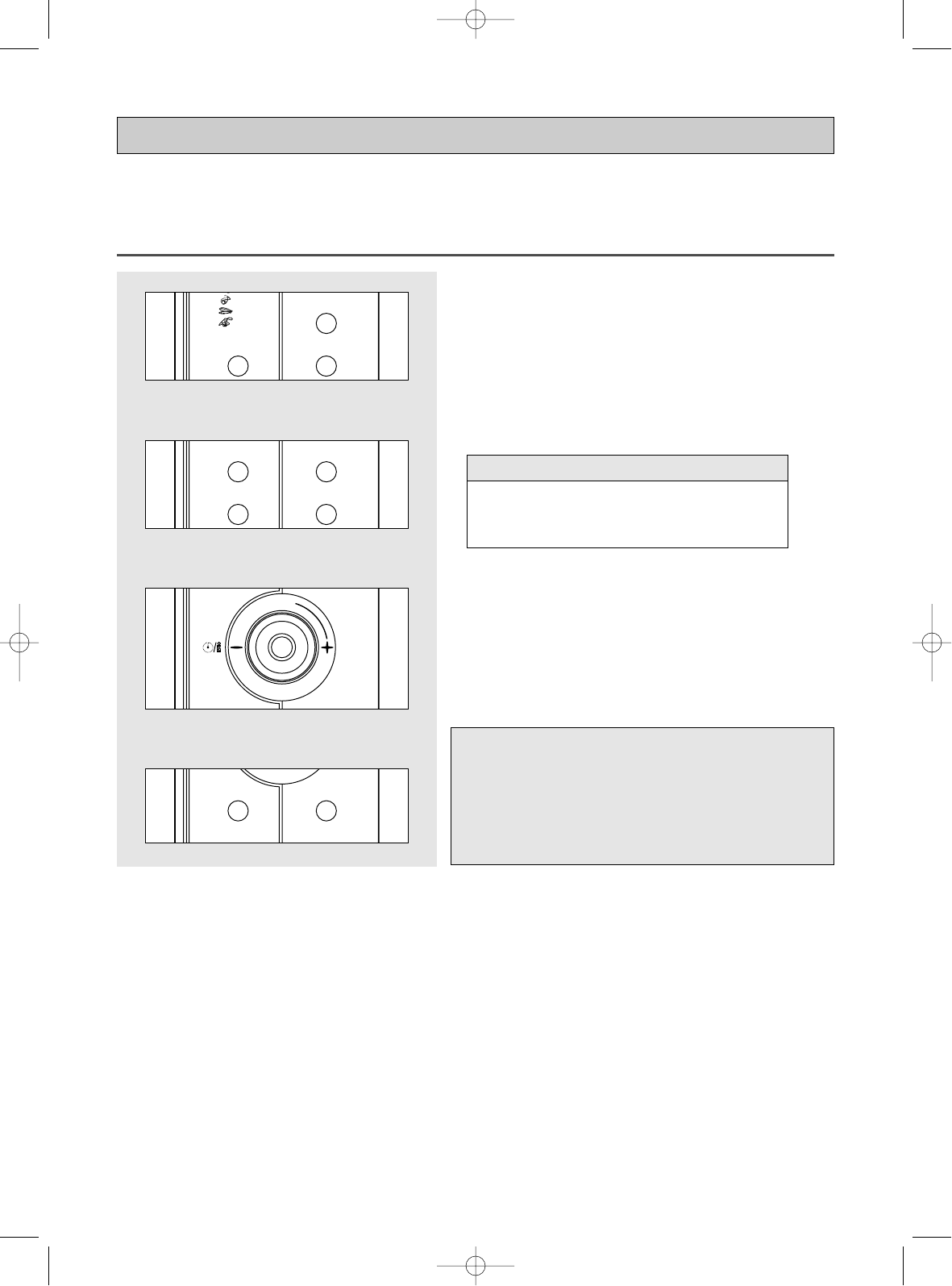
15
This function allows you to combine convection operation with microwave to produce traditional baked or roasted
results in less time.
Always use microwave-safe and oven-proof cookware. Glass or ceramic dishes are ideal as they allow the microwaves
to penetrate the food evenly.
Always use oven gloves when touching the recipients in the oven, as they will be very hot.
COMBINATION COOKING ( Microwave + Convection + Upper Grill )
1. Press Combi button once.
COMBI indicator light and "C-0" will show in the display.
2. Press Convection button once.
“110˚C”shows in display.
Select the convection cooking temperature by pressing the
Convection button again until the corresponding temperature
is displayed.
3. Turn the dial knob to set the cooking time.
For a cooking time of 11 minutes, turn the dial knob to the
right to set 11:00.( up to 60 minutes )
“11:00”shows in display.
4. Press START/SPEEDY COOK button.
The oven light comes on and the turntable starts rotating.
Cooking starts and the time in the display will count down.
Note: You can check the cooking temperature while
cooking is in progress by pressing the Convection
button.
The display will show the cooking temperature for 3
seconds.
In sequential operation mode, only “C-0” can be
selected.
Temperature sequence
110C → 120C → 130C → 140C → 150C →
160C → 170C → 180C → 190C → 200C →
210C → 220C → 230C → 240C → 250C →
Combi
Grill
Weight
Defrost
3. Roast chicken
4. Baked fish
5. Fresh vegetable
Ti
▲
✭✷
✣❏■❖❅❃▼❉❏■
✴❉❍❅
✤❅❆❒❏▲▼
✣●❏❃❋
▲
✴
❉
❍
❅
✏
✷
❅
❉
❇
❈
▼
✱
◆
❁
■
▼
❉
▼
❙
✳✴✡✲✴ ✏✳✴✯✰✏✣✬✥✡✲
✳✴✡✲✴ ✏ ✳✰✥✥✤✹ ✣✯✯✫✳✴✯✰✏✣✬✥✡✲
▲
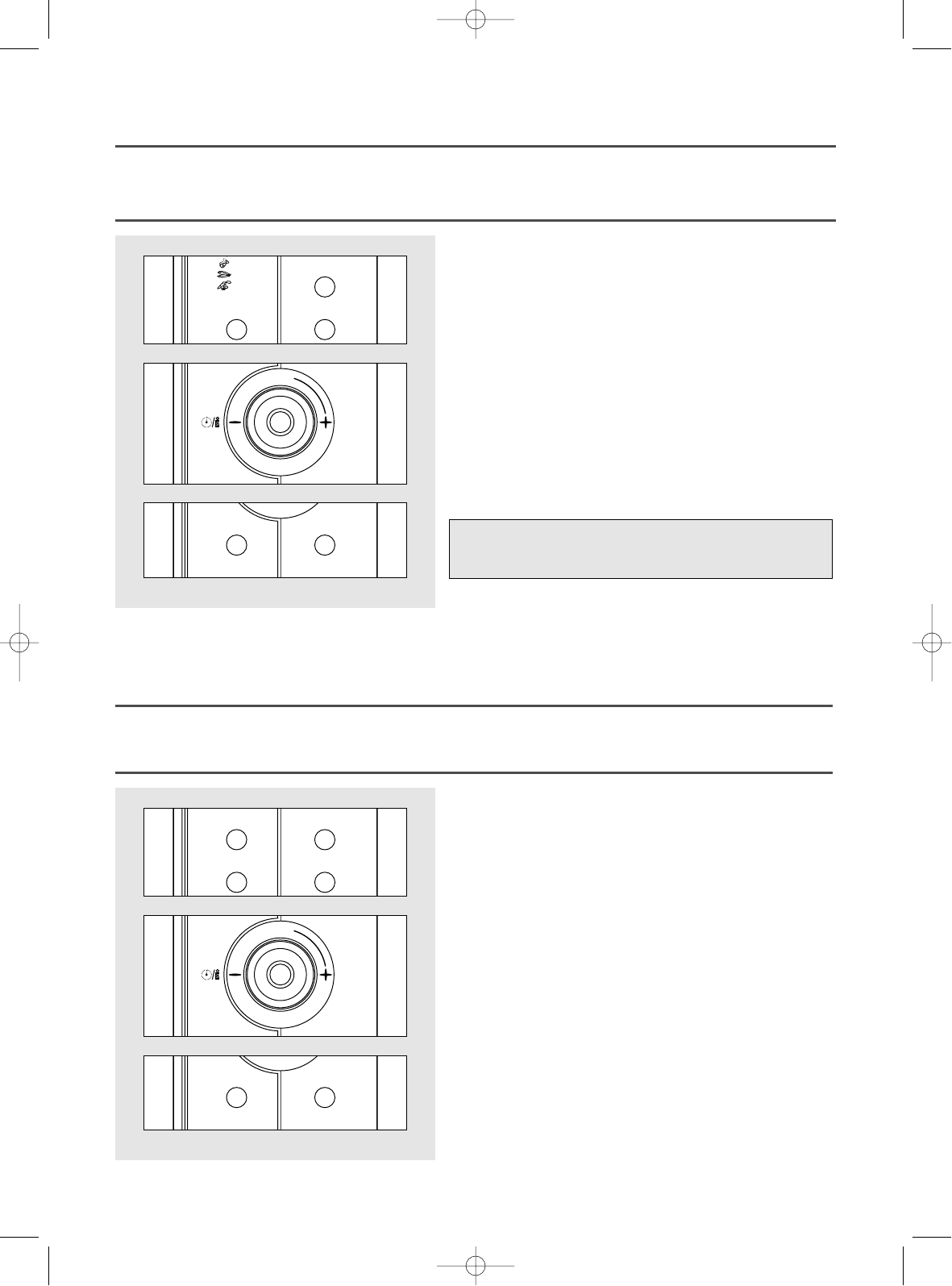
16
Weight Defrost automatically sets the defrosting times and power levels to give even defrosting results for frozen food.
During the defrosting process the oven will beep to remind you to check the food. The oven will beep, open the door,
turn the frozen food over and close the door, press the START/SPEEDY COOK button.
WEIGHT DEFROST
1. Press Weight Defrost button once. The Weight-Defrost
indicator lights an “: 0 ” is displayed. The “ll
b ” indicator
blinks.
2. Turn the dial knob to set the weight.
Weight can be set up from 0.5lb to 6.5lb .
The weight will change in 0.5lb increments or decrements.
For a defrosting weight of 2lb, turn the dial knob to the
right to set 2.0. "2.0 "shows in display.
3. Press START/SPEEDY COOK button.
The oven light comes on and the turntable starts rotating.
The “lb” indicator goes off.
Cooking starts and the time in the display will count down.
Combi
Grill
Weight
Defrost
3. Roast chicken
4. Baked fish
5. Fresh vegetable
Ti
▲
✴
❉
❍
❅
✏
✷
❅
❉
❇
❈
▼
✱
◆
❁
■
▼
❉
▼
❙
✳✴✡✲✴ ✏✳✴✯✰✏✣✬✥✡✲
✳✴✡✲✴ ✏ ✳✰✥✥✤✹ ✣✯✯✫✳✴✯✰✏✣✬✥✡✲
▲
During the defrosting process the oven will beep to remind you to check the food.
The oven will beep, open the door, turn the frozen food over and close the door, press the START/SPEEDY COOK
button.
TIME DEFROST
1. Press Time Defrost button once. The Time-Defrost
indicator lights and “: 0 ” is displayed.
2. Turn the dial knob to set the defrosting time.
For a time of 11 minutes, turn the dial knob to the right to
set 11:00.(up to 60 minutes)
"11:00 "shows in display.
3. Press START/SPEEDY COOK button.
The oven light comes on and the turntable starts rotating.
Cooking starts and the time in the display will count down.
MW
Convection
Time
Defrost
Clock
▲
✴
❉
❍
❅
✏
✷
❅
❉
❇
❈
▼
✱
◆
❁
■
▼
❉
▼
❙
✳✴✡✲✴ ✏✳✴✯✰✏✣✬✥✡✲
✳✴✡✲✴ ✏ ✳✰✥✥✤✹ ✣✯✯✫✳✴✯✰✏✣✬✥✡✲
▲
Note : WEIGHT DEFROSTING beging. The defrosting time is
cletermined datermined by the weight entered.
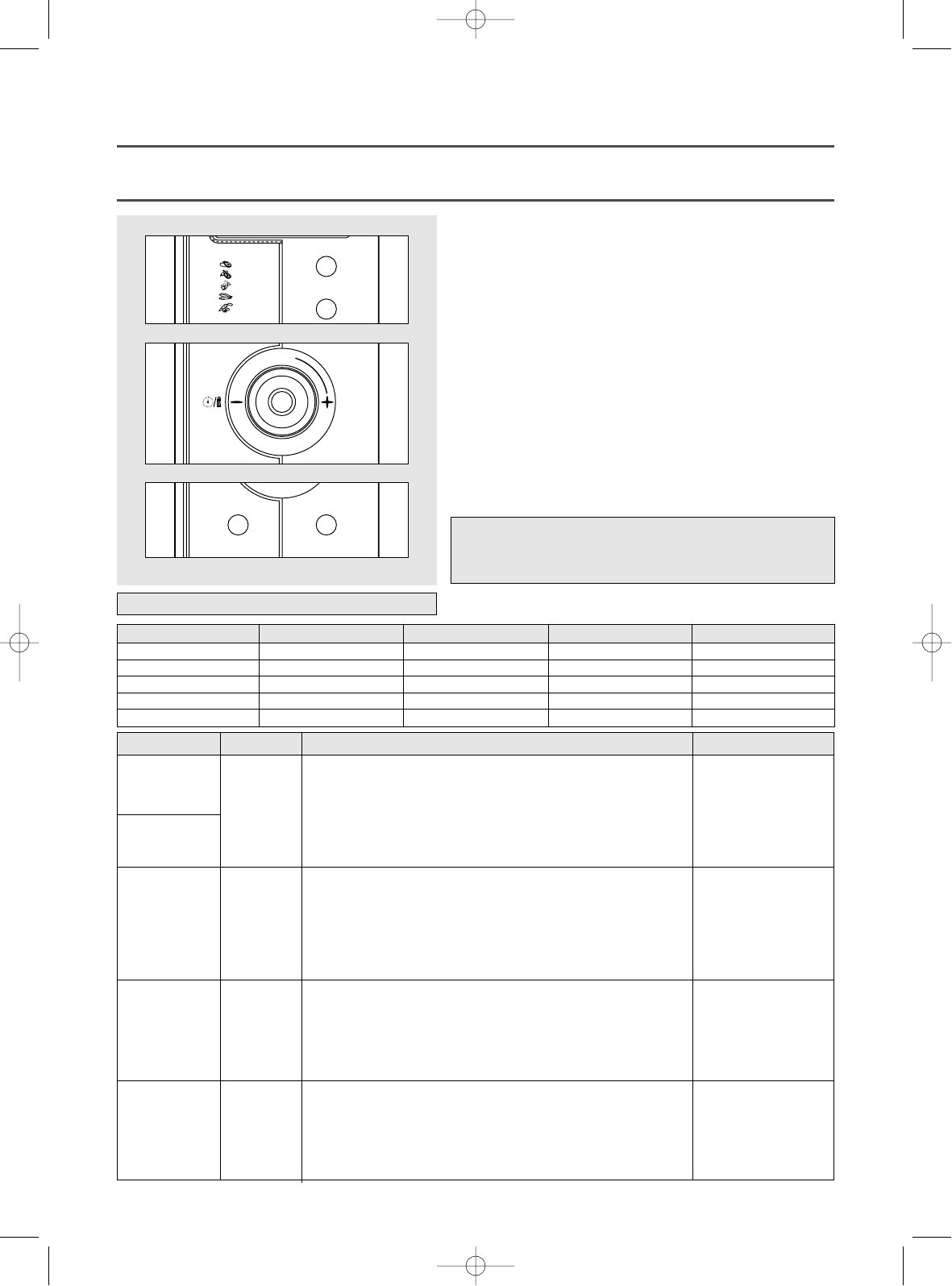
17
Auto Cook Menu Start Temp. Method Cookware
Place the pork or beef
directly on the
turntable.
Place the chicken
directly on the
turntable.
Micro and heat proof
shallow dish.
(e.g Pyrex.)
Microproof dish.
(e.g Pyrex.)
ROAST PORK
ROAST BEEF
ROAST CHICKEN
BAKED FISH
FRESH
VEGETABLES
Chilled temp.
Chilled temp.
Chilled temp.
1. Tie the joint into a neat shape.
2. Place the pork directly on the turntable.
3. Brush with a little oil.
4. Place roasts fat-side down a turntable tray.
5. Cook on "AUTO COOK-ROAST PORK or ROAST BEEF".
6. Turn over when hearing the beep.
7. Remove from oven. Drain off any excess juices.
8. Stand for 10 minutes in foil before serving.
1. Wash and dry chicken. Tie the legs loosely together with string.
2. Pierce the skin a couple of times just under the legs.
3. Brush butter mixture all over the chicken directly on the turntable.
4. Place roasts breast-side down a turntable tray.
5. Cook on "AUTO COOK-ROAST CHICKEN".
6. Turn over when hearing the beep.
7. Remove from oven. Drain off any excess juices. Season with salt if
required. Stand for 10 minutes in foil before serving.
1. All types of fresh fish(except battered or breadcrumbed fish) can be
cooked whether whole, fillets or steaks.
2. Place the prepared fish in a buttered dish.
3. Season with salt and pepper, sprinkle with lemon juice and dot with
butter. Do not cover dish.
4. Place on dish on the turntable.
5. Cook on "AUTO COOK- BAKED FISH".
1. Wash and trim.
2. Place prepared vegetables into a suitable sized container.
3. Sprinkle with 4-5 tbs. of water.
4. Cover with pierced cling film or a lid.
5. Place on dish on the turntable.
6. Cook on "AUTO COOK- FRESH VEGETABLES.
* For best results cut vegetables into similar sized pieces.
This function allows you to simply and automatically cook a range of popular foods.
Always use oven gloves when touching the recipients in the oven.
AUTO COOK
1. Press Auto Cook button once.
Auto Cook indicator light.
"AC-1 " will show in the display.
2. Select the menu by pressing the Auto Cook button until the
required menu is displayed.
Refer to the auto cook menu chart below for further details.
3. Turn the dial knob to set the cooking weight.
For a cooking weight of 2lb, turn the dial knob to the Right
to set 2lb.( up to 4.0lb )
"2.0" shows in display. "lb" shows in display.
Refer to the auto cook menu chart below for further details.
4. Press START/SPEEDY COOK button.
The oven light comes on and the turntable starts rotating.
Cooking starts and the time in the display will count down.
Auto Cook Menu Chart
Press auto cook key
Once
Twice
3 times
4 times
5 times
Auto Cook Menu
ROAST PORK
ROAST BEEF
ROAST CHICHEN
BAKED FISH
FRESH VEGETABLE
Minimum Weight
1 lb
1 lb
1.6 lb
0.6 lb
0.2 lb
Maximum Weight
4 lb
4 lb
6 lb
2 lb
2 lb
Weight Step
0.2 lb
0.2 lb
0.2 lb
0.2 lb
0.1 lb
Auto cook
Combi
Wiht
Auto Cook Menu
1. Roast pork
2. Roast beef
3. Roast chicken
4. Baked fish
5. Fresh vegetable
▲
✴
❉
❍
❅
✏
✷
❅
❉
❇
❈
▼
✱
◆
❁
■
▼
❉
▼
❙
✳✴✡✲✴ ✏✳✴✯✰✏✣✬✥✡✲
✳✴✡✲✴ ✏ ✳✰✥✥✤✹ ✣✯✯✫✳✴✯✰✏✣✬✥✡✲
▲
Note : You can check the setting cooking menu while the
cooking is in progress by pressing the Auto Cook
button.
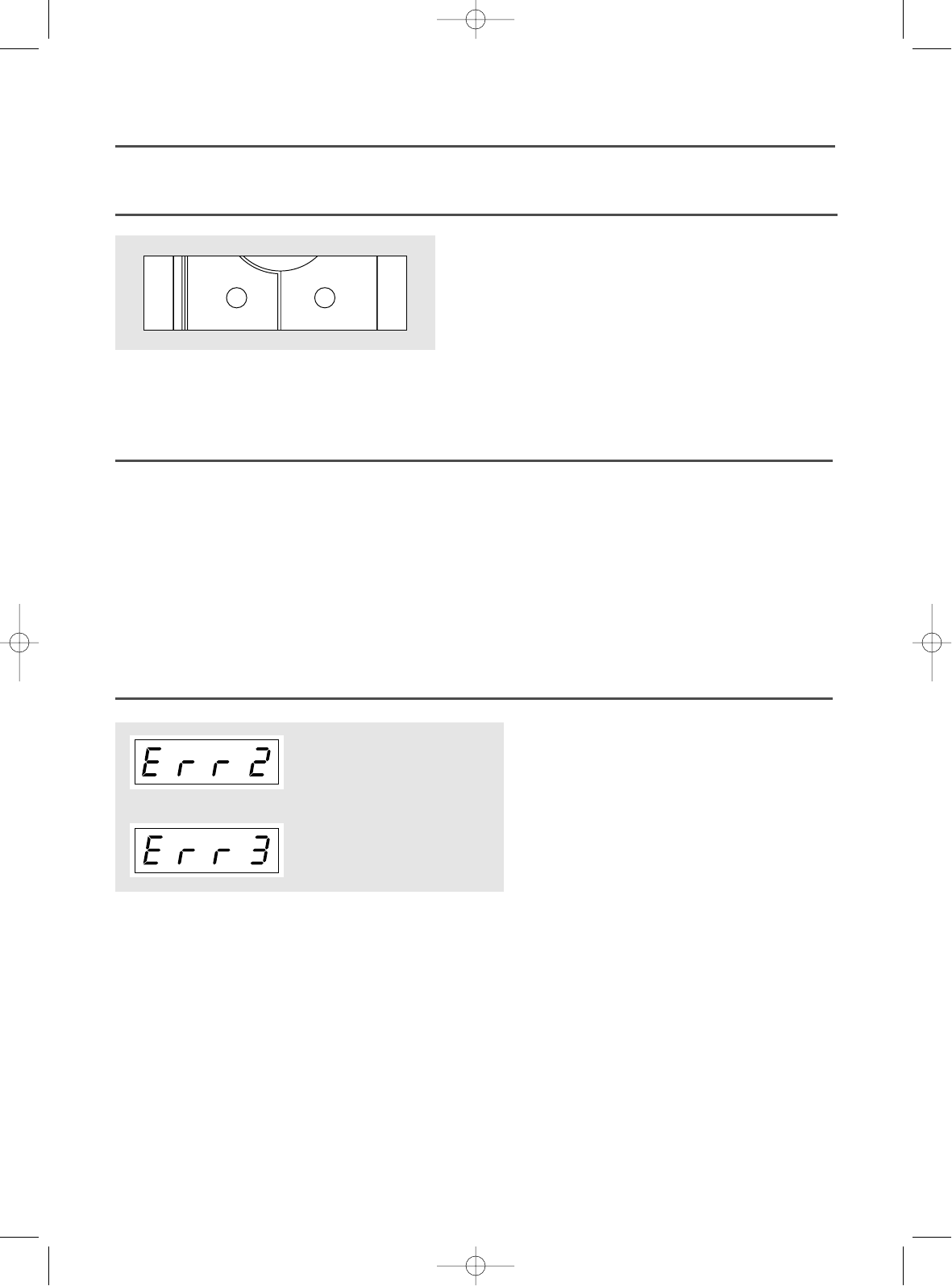
18
The speedy cook function allows the oven to being cooking immediately on full power.
The speedy cook button has been pre-programmed to increase in increments of 30 seconds up to a maximum time of
5 minutes.
SPEEDY COOK
1. Press START/SPEEDY COOK button.
The oven will be " : 30" is displayed. MW indicator lights.
And the oven will start immediately. No need to press
START/SPEEDY COOK button.
The oven light comes on and the turn table starts rotaing and
the time in the display will count down in seconds.
START / SPEEDY COOKSTOP/CLEAR
1. Open the door.
• Oven stops operating.
• You can restart the oven by closing the door and touching START/SPEEDY COOK button.
2. Press the STOP/CLEAR button.
• Oven stops operating.
• If you wish to cancel the cooking settings, press the STOP/CLEAR button again.
TO STOP THE OVEN WHILE THE OVEN IS OPERATING
ABNORMAL MESSAGE
• If the inside temperature of the oven is higher
than expected or the temperature sensor doesn't
work properly, "Err 2" message will be shown in
the display.
• Unplug the power and call our technical service.
• When the temperature sensor is disconnected,
"Err 3" message will be shown in the display.
• Unplug the power and call our technical service.
▲
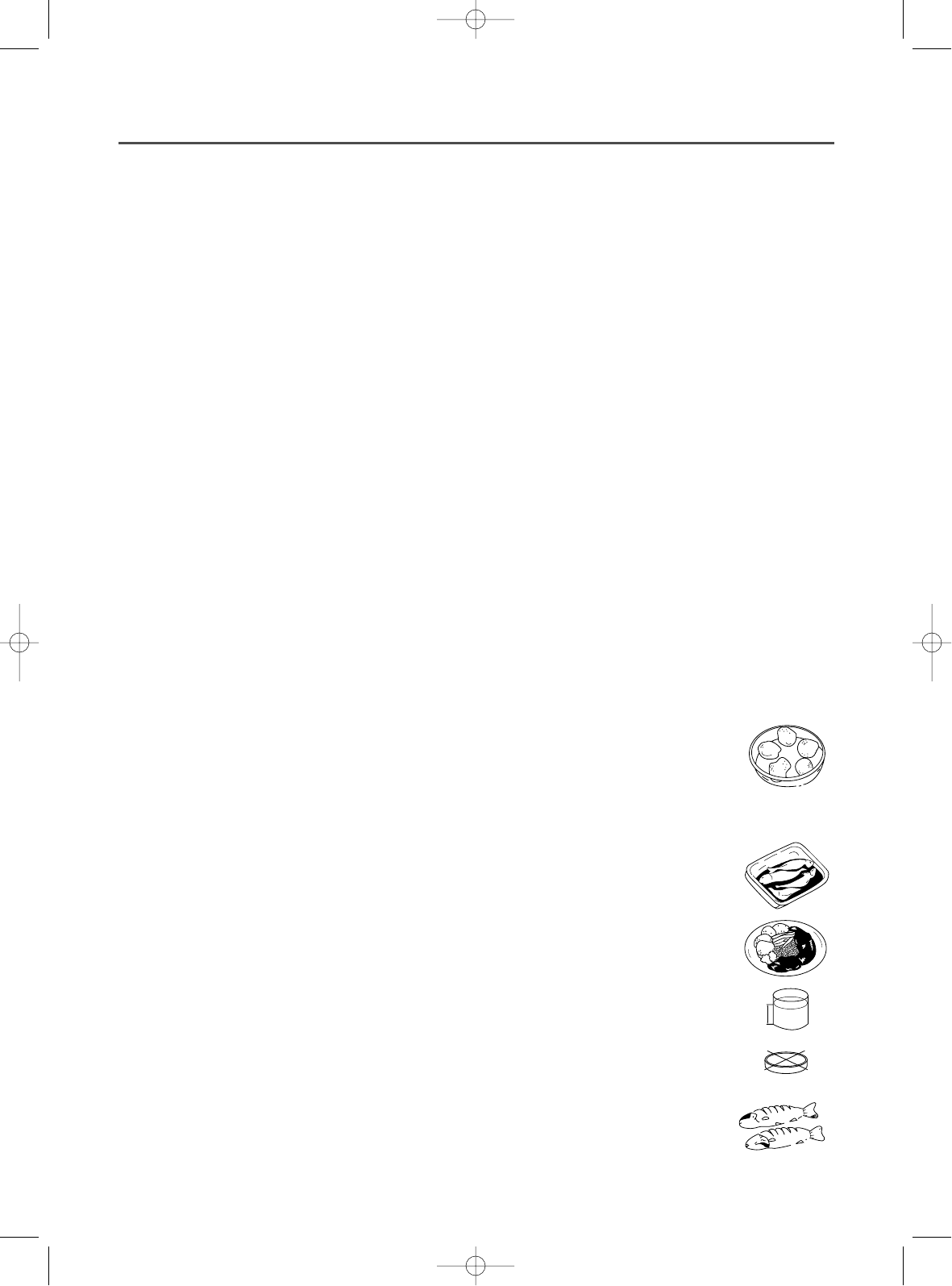
19
GENERAL GUIDE LINES
Since microwave cooking to some extent is different from
traditional cooking, the following general guidelines should be
considered whenever you use your microwave oven
If the food is undercooked
Check if:
• You have selected the correct power level.
• The selected time is sufficient-the times given in the recipes
are approximate. They depend on initial temperature, weight
and density of the food etc.
• The container is appropriate.
If the food is overcooked,i.e. dried out or burnt
Before you cook again, consider whether:
• The power level was too high.
• The set time was too long-the times in the recipes are
approximate. They depend on initial temperature, weight and
density of the food etc.
Points to remember when defrosting
• The shape of the package alters the defrosting time. Shallow
rectangular packets defrost more quickly than a deep block.
Separate pieces as they begin to defrost; freef low slices
defrost more easily.
• Shield areas of food with small pieces of foil if they start to
become warm.
• When defrosting, it is better to under thaw the food slightly and
allow the process to finish during the standing time.
The amount of food
The more food you want to prepare the longer it takes. A rule of
thumb is that double amount of food requires almost double the
time. If one potato takes four minutes to cook, approximately
seven minutes are required to cook two potatoes.
Starting temperature of food
The lower the temperature of the food which is being put into the
microwave oven, the longer time it takes. Food at room
temperature will be reheated more quickly than food at
refrigerator temperature.
Composition of the food
Food with a lot of fat and sugar will be heated faster than food
containing a lot of water. fat and sugar will also reach a higher
temperature than water in the cooking process.
The more dense the food, the longer it takes to heat. “Very
dense” food like meat takes longer time to reheat than lighter,
more porous food like sponge cakes.
Size and shape
Smaller pieces of food will cook more quickly than larger pieces
and uniform pieces of food cook more evenly than irregularly
shaped foods.
With unevenly shaped food, the thinner parts will cook faster
than the thicker areas. Place the thinner chicken wings and legs
to the centre of the dish.
Stirring, turning of foods
Stirring and turning of foods are techniques used in conventional
and well as in microwave cooking to distribute the heat quickly to
the centre of the dish and avoid over-cooking at the outer edges
of the food.
Covering food helps:
• To reduce spattering
• To shorten cooking times
• To retain food moisture
All covering, which will allow microwaves to pass through are
suitable-See above “Which utensils can be used in the oven?”
Releasing pressure in foods
Several foods are tightly covered by a skin or membrane.
These foods should be pricked with a fork or cocktail stick to
release the pressure and to prevent bursting, as steam builds up
within them during cooking. This applies to potatoes, chicken
livers, sausages, egg yolks and some fruits.
Standing time
Always allow the food to stand for some time after using the
oven. standing time after defrosting, cooking/reheating always
improves the result since the temperature will then be evenly
distributed through out the food.
In a microwave oven foods continue to cook even when the
microwave energy is turned off. They are no longer cooking by
microwaves, but they are still being cooked by the conduction of
the high residual heat to the centre of the food.
The length of standing time depends on the volume and density
of the food. Sometimes it can be as short as the time it takes you
to remove the food from the oven and take it to the serving table.
However, with larger, denser foods, the standiing time may be
as long as 10 minutes. During ‘standing’, the internal
temperature of the food will rise by as much as 8˚C and the food
will finish cooking in this time.
Arranging food
This is done in several ways in microwave cooking to give more
even cooking results.
If you are cooking several items of the same food such as jacket
potatoes, place them in a ring pattern for uniform
cooking. When cooking foods of uneven shapes
or thickness, place the smaller or thinner area
of the food towards the centre of the dish
where it will be heated last.
Uneven foods such as fish should be arranged in the oven with
the tails to the centre.
If you are saving a meal in the refrigerator or ‘plating’
a meal for reheating, arrange the thicker,
denser foods to the outside of the
plate and the thinner or less dense foods
in the middle.
Place thin slices of meat on top of each
other or interlace them. Thicker slices such as
meat loaf and sausages have to be placed
close to each other. Gravy or sauce should be
reheated in a separate container.
Choose a tall, narrow container rather than a low
and wide container. When reheating gravy,
sauce or soup, do not fill the container more than
2/3.
When you cook or reheat whole fish, score the
skin this prevents cracking.
Shield the tail and head with small pieces of
foil to prevent over-cooking but ensure the foil
does not touch the sides of the oven.
2/3

20
COOKING UTENSILS
Recommended Use
•Glass and glass-ceramic bowls and Dishes - Use for heating or cooking.
• Microwave browning dish - Use to brown the exterior of small items such as steaks, chops, or pancakes.
Follow the directions provided with you browning dish.
• Microwaveable plastic wrap - Use to retain steam. Leave a small opening for some steam to escape and
avoid placing it directly on the food.
• Wax paper - Use as a cover to prevent spattering.
• Paper towels, and napkins - Use for short term heating and covering; they absorb excess moisture and
prevent spattering. Do not use recycled paper towels, which may contain metal and can eatch fire.
• Thermometers - Use only those labeled “Microwave Safe” and follow all directions. Check the food in several
places. Conventional thermometers may be used once the food has been removed from the oven.
• Microwave cling film, microwave roasting bags - Microwave cling film and bags must be vented for steam
to escape, pierce in 4~5 places. Do not use plastic or metal ties as they may melt or catch fire due to electrical
‘arcing’.
Limited Use
• Aluminum foil - Use narrow strips of foil to prevent overcooking of exposed areas. Using too much toil can
damage your oven, so be careful.
• Ceramic, porcelain, and stoneware - Use these if they are labeled “Microwave Safe.” If they are not
labeled, test them to make sure they can be used safely. Never use dishes with metalic trim.
• Plastic - Use only if labeled “Microwave Safe.” Other plastics can melt.
• Thin plastic, paper, straw and wooden containers - Always attend the oven closely. Look at the oven from
time to time when cooking or reheating food in disposable containers of plastic, paper or other combustible
material. Only use for warming food. Pay special attention as over-heating may cause a fire in your oven.
Not Recommended
• Glass jars and bottles - Regular glass is too thin to be used in a microwave, and can shatter.
• Paper bags - These are a fire hazard, except for popcorn bags that are designed for microwave use.
• Styrofoam plates and cups - These can melt and leave an unhealthy residue on food.
• Plastic storage and food containers - Containers such as margarine tubs can melt in the microwave.
• Metal utensils - These can damage your oven. Remove all metal before cooking.
COOKING INSTRUCTIONS
Utensils should be checked to ensure that they are suitable for use in microwave ovens.
UTENSILS TEST
Place the utensil in question next to a glass measure filled with water, in the microwave oven. Microwave at
high power for 1-2 minutes. If the water heats up, but the utensil remains cool, the utensil is microwave-safe.
However if the utensil becomes warm, microwaves are being absorbed by the utensil and it should not be in the
microwave oven. You probably have many items on hand in your kitchen right now that can be used as cooking
equipment in your microwave oven. Read through the following checklist.
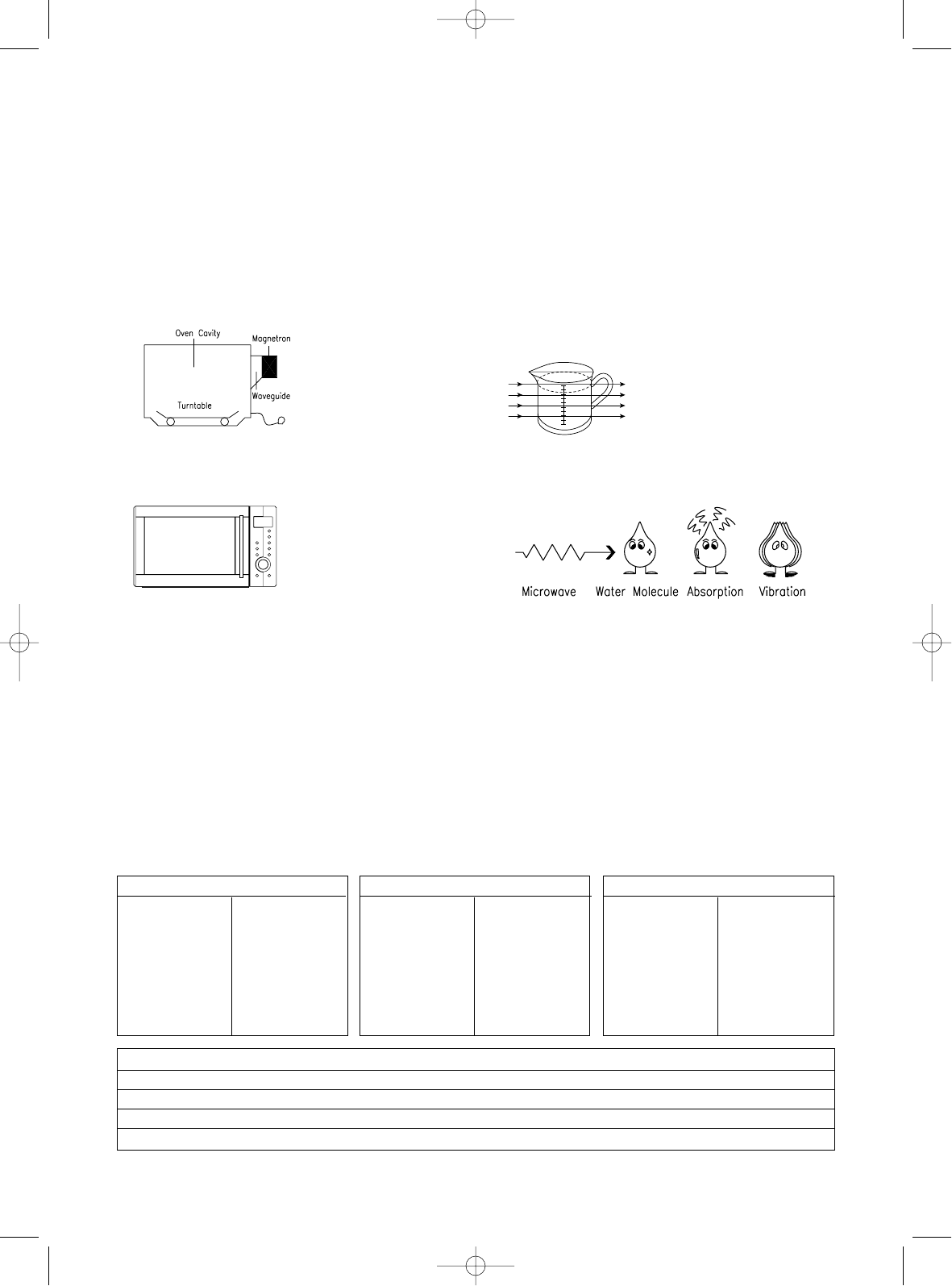
21
MICROWAVING PRINCIPLES
Microwave energy has been used in this country to cook and reheat food since early experiments with
RADAR in World War ll. Microwaves are present in the atmosphere all the time, both naturally and
manmade sources. Manmade sources include radar, radio, television, telecommunication links and car
phones.
CONVERSION CHARTS
In a microwave oven,
electricity is
converted into
microwave by the
MAGNETRON.
REFLECTION The microwaves
bounce off the metal
walls and the metal
door screen.
TRANSMISSION Then they pass through
the cooking containers to
be absorbed by the water
molecules in the food, all
foods contain water to a
more or lesser extent.
ABSORPTION
The microwaves cause the water molecules to
vibrate which causes FRICTION, i.e. HEAT. This
heat then cooks the food. Microwaves are also
attracted to fat and sugar particles, and foods high
in these will cook more quickly. Microwaves can
only penetrate to a depth of 11/2 - 2 inches(4-5cm)
and as heat spreads through the food by
conduction, just as in a traditional oven, the food
cooks from the outside inwards.
WEIGHT MEASURES
15 g 1/2oz.
25 g 1 oz.
50 g 2 oz.
100 g 4 oz.
175 g 6 oz.
225 g 8 oz.
450 g 1 lb.
HOW MICROWAVES COOK FOOD
▲
▲▲
VOLUME MEASURES
30 ml 1 fl.oz.
100 ml 3 fl.oz.
150 ml 5 fl.oz. (1/4 pt)
300 ml 10 fl.oz. (1/2 pt)
600 ml 20 fl.oz. (1pt)
SPOON MEASURES
1.25 ml 1/4tsp
2.5 ml 1/2tsp
5 ml 1 tsp
15 ml 1 tbsp
FLUID MEASUREMENTS
1 Cup = 8 fl.oz. = 240 ml
1 Pint = 16 fl.oz. (UK 20 fl.oz.) = 480 ml (UK 560 ml)
1 Quart = 32 fl.oz. (UK 40 fl.oz.) = 960 ml (UK 1120 ml)
1 Gallon = 128 fl.oz. (UK 160 fl.oz.) = 3840 ml (UK 4500 ml)

22
STANDING TIME
Dense foods e.g. meat, jacket potatoes and cakes,
require standing time(inside or outside of the oven)
after cooking, to allow heat to finish conducting to
cook the center completely. Wrap meat joints and
jacket potatoes in aluminium foil while standing.
Meat joints need approx. 10-15 minutes, jacket
potatoes 5 minutes. Other foods such as plated
meal, vegetables, fish etc require 2-5 minutes
standing. After defrosting food, standing time
should also be allowed. If food is not cooked after
standing time, return to the oven and cook for
additional time.
MOISTURE CONTENT
Many fresh foods e.g. vegetables and fruit, vary in
their moisture content throughout the season,
particularly jacket potatoes. For this reason cooking
times may have to be adjusted. Dry ingredients e.g.
rice, pasta, can dry out during storage so cooking
times may differ.
DENSITY
Porous airy foods heat more quickly than dense
heavy foods.
CLING FILM
Cling film helps keep the food moist and the
trapped steam assists in speeding up cooking
times. Pierce before cooking to allow excess steam
to escape. Always take care when removing cling
film from a dish as the build-up of steam will be
very hot.
SHAPE
Even shapes cook evenly. Food cooks better by
microwave when in a round container rather than
square.
SPACING
Foods cook more quickly and evenly if spaced
apart. NEVER pile foods on top of each other.
STARTING TEMPERATURE
The colder the food, the longer it takes to heat up.
Food from a fridge takes longer to reheat than food
at room temperature.
LIQUIDS
All liquids must be stirred before and during
heating. Water especially must be stirred before
and during heating, to avoid eruption. Do not heat
liquids that have previously been boiled. DO NOT
OVERHEAT.
TURNING & STIRRING
Some foods require stirring during cooking. Meat
and poultry should be turned after half the cooking
time.
ARRANGING
Individual foods e.g. chicken portions or chops,
should be placed on a dish so that the thicker parts
are towards the outside.
QUANTITY
Small quantities cook faster than large quantities,
also small meals will reheat more quickly than large
portions.
PIERCING
The skin or membrane on some foods will cause
steam to build up during cooking. These foods
must be pierced or a strip of skin should be peeled
off before cooking to allow the steam to escape.
Eggs, potatoes, apples, sausages etc, will all need
to be pierced before cooking. DO NOT ATTEMPT
TO BOIL EGGS IN THEIR SHELLS.
COVERING
Cover foods with microwave cling film or a lid.
Cover fish, vegetables, casseroles, soups. Do not
cover cakes, sauces, jacket potatoes or pastry
items.
COOKING TECHNIQUES

23
DEFROSTING GUIDE
GENERAL INFORMATION
➪Put the food on a microwave rack (roasts, bone-in pieces) or in a microwave casserole (small pieces
such as cubes or strips) or weigh at home on a kitchen scale. Round number to the nearest tenth of a
pound and choose that number with each item pads.
➪The shape of food items, especially larger ones, will vary affect the way defrost. Always check the status
after the standing time. Fish, seafood and poultry should still be somewhat icy in the center the held
under cold running water to finish defrosting. If more time is needed, use DEFROST by time to add time
in small increments.
➪Halfway through the defrosting process, a series of beeps will indicate that it is time to change the
position of the item being defrosted. The includes turning over or rotating the item, separating defrosted
pieces or sections, or shielding.
➪Shielding means to use a 2-inch strip of aluminum foil to protect thinner or unevenly shaped part from
beginning to cook. Microwave energy will not penetrate the foil. Some rules apply to the use of foil:
Do not let the foil pieces touch each other or the sides of the microwave oven.
Be sure that all ends are touched under and lie flat to the food.
Remember to adjust foil when a item is turned over and cover with wax paper.
➪To prepare food for freezer storage(and later defrosting), wrap tightly in moisture proof packaging. If
using freezer plastic bags, be sure to let all the air out to prevent freezer bump on the food. Package so
that food is as evenly shaped as possible ease in defrosting
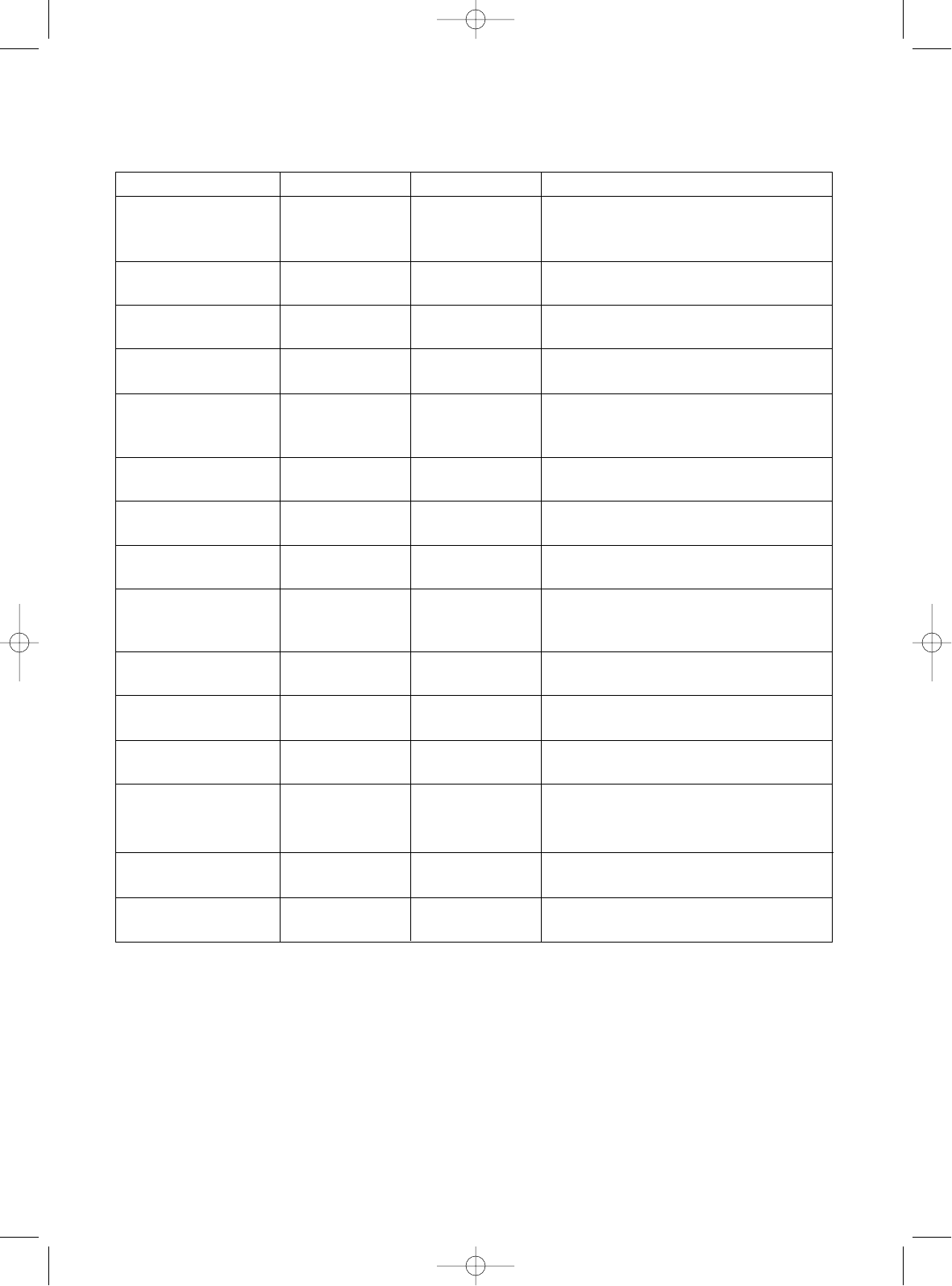
24
DEFROSTING CHART
Item and Weight
BEEF
Mineed beef
454g (1 lb.)
Stew Meat
681 (11/2 lbs.)
Loin Roast
907g (2 lbs.)
Patties
4 (113g (4 oz.))
PORK
Loin Roast
907g (2 lbs.)
Spareibs
454g (1 lb.)
Chops
4 (142g (5 oz.))
Minced
454g (1 lb.)
POULTRY
Whole Chicken
1134g (21/2 lbs.)
Chicken Breasts
454g (1 lb.)
Fryer Chicken
(cut up) 907g (2 lbs.)
Chicken Thighs
681g (11/2 lbs.)
FISH & SEAFOOD
Whole Fish
454g (1 lb.)
Fish Fillets
681g (11/2 lb.)
Shrimp
227g (1/2 lb.)
* The times are approximate because freezer temperatures vary.
Special Techniques
Break apart and remove thawed
portions with fork.
Separate and rearrange once.
Turn over after half the time.
Shield as needed.
Turn over after half the time.
Turn over after half the time.
Shield as needed.
Turn over after half the time.
Shield as needed.
Separate and rearrange once.
Separate and turn over once.
Break apart and remove thawed
portions with fork.
Breat side down. Turn over after half
the time.
Shield as needed.
Separate and rearrange once.
Separate and rearrange once.
Separate and rearrange once.
Separate and turn over once.
Separate and rearrange once.
Defrosting Time
5-7 min.
6-8 min.
10-12 min.
2-4 min.
8-10 min.
3-5 min.
3-5 min.
4-6 min.
10-14 min.
5-7 min.
7-9 min.
6-10 min.
2-3 min.
3-4 min.
1-2 min.
Standing Time
5-7 min.
5-7 min.
5-7 min.
5-7 min.
7-10 min.
5-7 min.
5-7 min.
5-7 min.
10-15 min.
5-7 min.
5-7 min.
5-7 min.
5-7 min.
5-7 min.
5-7 min.
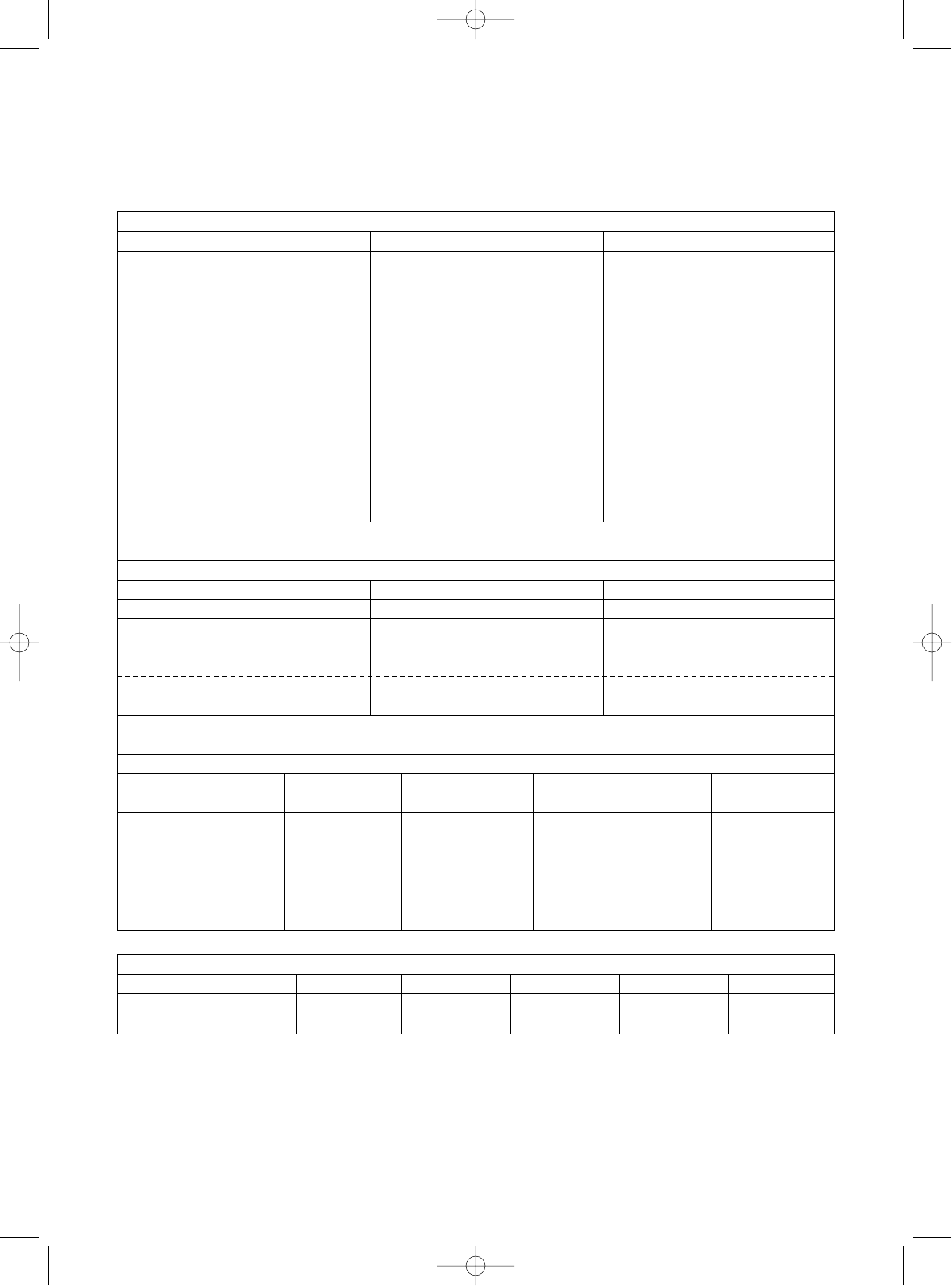
25
COOKING CHART
MEAT ITEM POWER LEVEL COOKING TIMER PER POUND
Beef
Standing/rolled Rib - Rare P-80 5-7 min.
- Medium P-80 6-8 min.
- well done P-80 7-9 min.
Ground Beef(to brown for casserole) P-HI 4-6 min.
Hamburgers, Fresh or defrosted
(4 oz. Each) 2 patties P-HI 1-2 min.
4 patties P-HI 2-3 min.
Pork
Loin, Leg P-80 8-10 min.
Bacon 4 slices P-HI 1-2 min.
6 slices P-HI 2-3 min.
NOTE: The above times should be regarded only as a guide. Allow for difference in individual tastes
and preferences. The times may vary due to the shape, cut, and composition of the meat.
POULTRY ITEM POWER LEVEL COOKING TIMER PER POUND
Chicken
Whole P-HI 5-7 min.
Breast(boned) P-80 3-5 min.
portions P-80 4-6 min.
Turkey
Whole P-HI 7-10 min.
NOTE: The above times should be regarded only as a guide. Allow for difference in individual tastes
and preferences. The times may vary due to the shape and composition of the food.
FRESH FISH
VEGETABLE
ITEM POWER COOKING TIME METHOD STANDING
LEVEL PER POUND TIME
Fish Fillets P-HI 2-3 min. Add 15-30 ml(1-2 Tbsp) 2-3 min.
Whole Mackerel, P-HI 2-3 min. - 3-4 min.
Cleaned and Prepared
Whole Trout, Cleaned P-HI 3-5 min. - 3-4 min.
and Prepared
Salmon Steaks P-HI 3-5 min. Add 15~30 ml(1~2 Tbsp) 3-4 min.
ITEM POWER LEVEL PREPARATION QUANTITY COOKING TIME
STANDING TIME
Artichokes, fresh P-HI Whole 4(8 oz. each) 5-7 min. 5 min.
Artichokes, frozen P-HI Hearts 250g(9 oz. pkg) 6-8 min. 5 min.
Check time per 1lb. in chart below and multiply by the weight of the item.
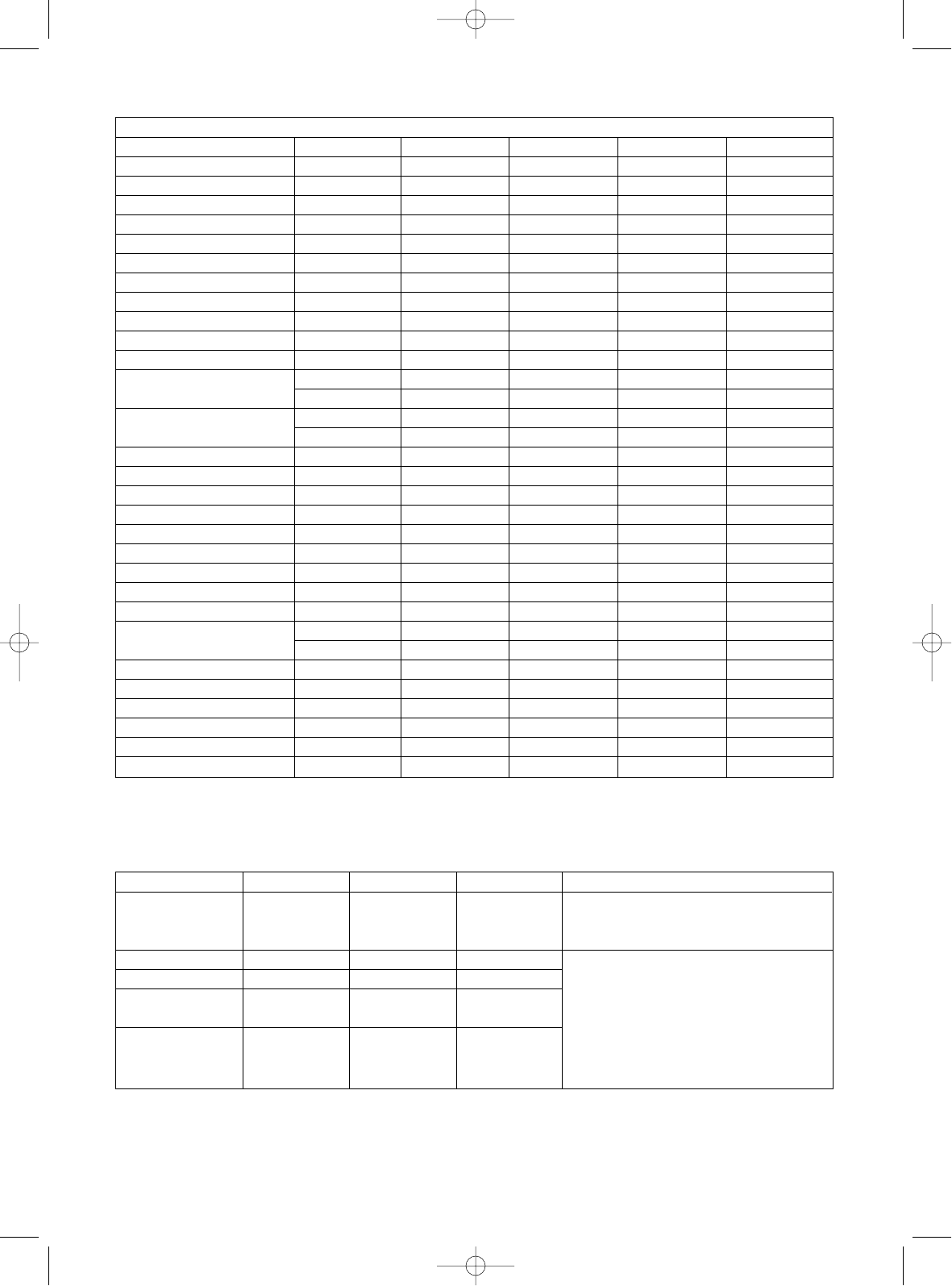
26
VEGETABLE
ITEM POWER LEVEL PREPARATION QUANTITY COOKING TIME
STANDING TIME
Asparagus, fresh P-HI 11/2-in.pieces 500g(1 lb.) 3-5 min. 3 min.
Asparagus, frozen P-HI Whole spears 280g(10 oz. pkg) 5-7 min. 3 min.
Broccoli, fresh P-HI Spears 500g(1 lb.) 3-5 min. -
Broccoli, frozen P-HI Whole or cut 280g(10 oz. pkg) 5-7 min. 3 min.
Brussels sprouts, fresh P-HI Whole 280g(10 oz. tub) 3-5 min. -
Brussels sprouts, frozen P-HI Whole 280g(10 oz. pkg) 5-7 min. 3 min.
Carrots, fresh P-HI 1/2-in.slices 500g(1 lb.) 4-6 min. 3 min.
Carrots, frozen P-HI Sliced 280g(10 oz. pkg) 3-4 min. 3 min.
Cauliflower, frozen P-HI florets 280g(10 oz. pkg) 3-4 min. 3 min.
Celery, fresh P-HI 1/2-in.slices 500g(1 lb.) 3-5 min. 5 min.
Corn, fresh P-HI on cob, husked 4 ears 5-7 min. 5 min.
Corn, frozen P-HI on cob, husked 4 ears 5-7 min. 5 min.
P-HI whole kernel 280g(10 oz. pkg) 4-6 min. 3 min.
Eggplant, fresh P-HI cubed 500g(1 lb.) 3-5 min. 3 min.
P-HI whole, pierced
500~700g(1-11/2lb.)
4-6 min. 5 min.
Leeks fresh P-HI whole, ends 500g(1 lb.) 4-6 min. 5 min.
Lima beans, frozen P-HI whole 280g(10 oz. pkg) 4-6 min. 3 min.
Mixed vegetables frozen P-HI - 280g(10 oz. pkg) 4-6 min. 3 min.
Mushrooms, fresh P-HI sliced 500g(1 lb.) 2-3 min. 3 min.
Okra, frozen P-HI sliced 280g(10 oz. pkg) 4-6 min. 5 min.
Onions, fresh P-HI whole, peeled 8-10 small 5-7 min. 5 min.
Pea pods(snow peas), frozen P-HI whole 170g(6 oz. pkg) 2-3 min. 3 min.
Peas and carrots P-HI - 280g(10 oz. pkg) 2-3 min. 3 min.
Parsnips, fresh P-HI cubed 500g(1 lb.) 4-6 min. 5 min.
Potatoes, white or sweet, P-HI whole 4(6 oz. eash) 15-17 min. 3 min.
fresh P-HI whole 8(6 oz. eash) 18-20 min. 5 min.
Squash, summer, fresh P-HI 1/2-in.slices 500g(1 lb.) 3-5 min. 3 min.
Squash, summer, frozen P-HI sliced 280g(10 oz. pkg) 3-5 min. 3 min.
Squash, winter, fresh P-HI whole, pierced 700g(11/2lbs.) 6-8 min. 5 min.
Squash, winter, frozen P-HI whipped 340g(12 oz. pkg) 4-6 min. 3 min.
Succotash, frozen P-HI - 280g(10 oz. pkg) 3-5 min. 3 min.
Turnips P-HI cubed 4 cups 4-6 min. 3 min.
ITEM QUANTITY POWER LEVEL COOKING TIME SPECIAL INSTRUCTION
Appetizers
(bite size) 2 servings P-HI 1-2 min.
Breakfast entrée 110~140g(4-5 oz.) P-HI 1-2 min.
Entrée 250g(8-9 oz.) P-HI 6-8 min.
Regular TV-style 600g(21 oz.) P-HI 10-12 min.
dinner
Hearty TV-style 300g(11 oz.) P-HI 4-6 min.
dinner 480g(17 oz.) P-HI 5-8 min.
Heat 12 at time on paper towel lined
paper plate or microwave oven
roasting rack
If containers is 3/4-inch deep, remove
foil cover and replace foil tray in
original box.
For containers more then 3/4-inch
deep, remove food to similar size glass
container; heat, covered. If no top crust
stir occasionally.
REHEATING CHART
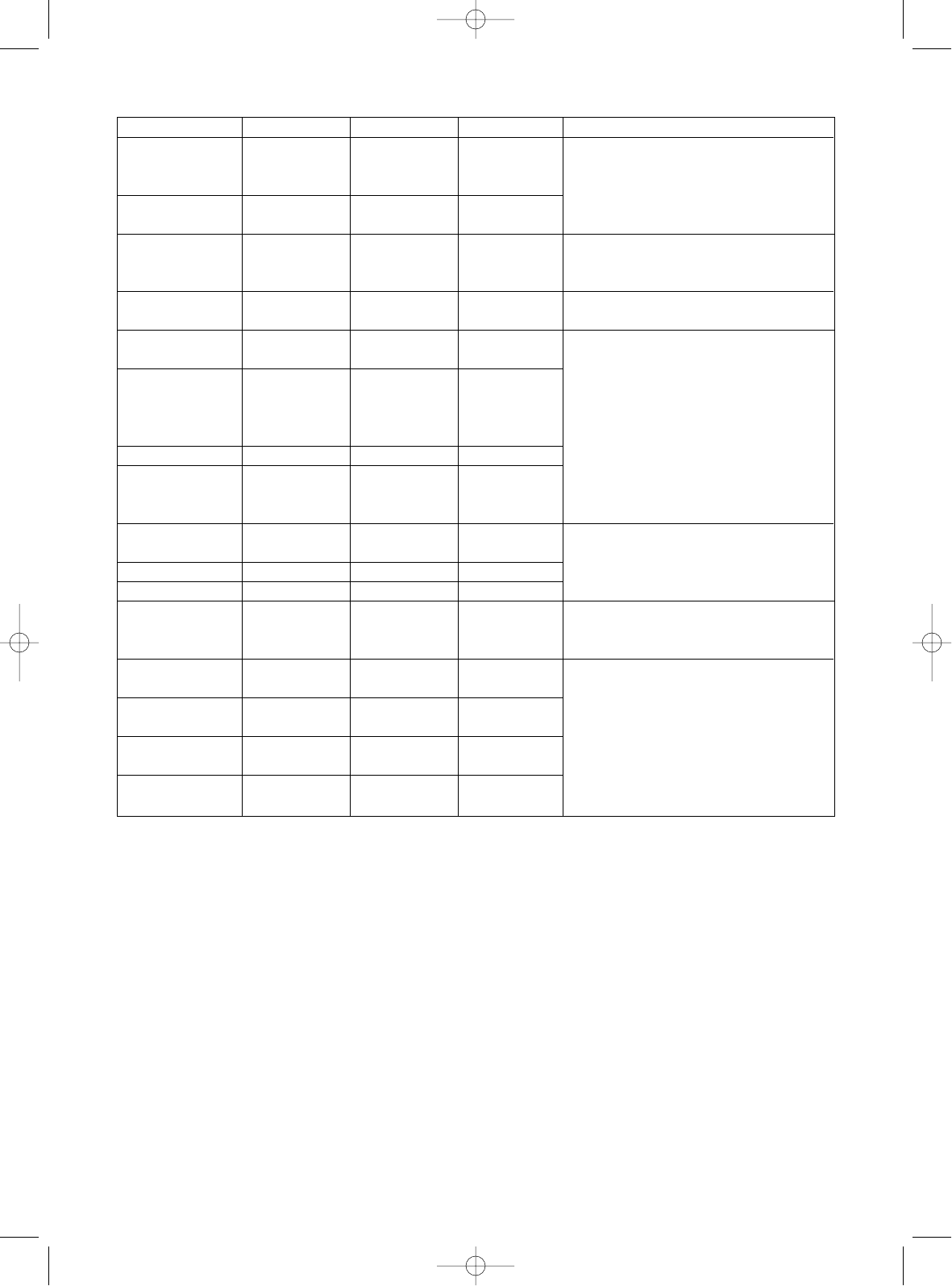
27
ITEM QUANTITY POWER LEVEL COOKING TIME SPECIAL INSTRUCTION
2 pieces P-HI 1-2 min.
Fried chicken 4 pieces P-HI 2-4 min.
6 pieces P-HI 3-5 min.
Fried fresh fillets 2 fillets P-HI 1-2 min.
4 fillets P-HI 2-4 min.
1 P-HI 1-2 min.
Pizzas (sliced) 2 P-HI 2-3 min.
4 P-HI 3-6 min.
Pouch dinners
140~160g(5-6 oz.)
P-HI 2-3 min.
280~300g(10-11 oz.)
P-HI 5-7 min.
Bagels 2 P-60 1-2 min.
4 P-60 2-4 min.
1 P-60 1/2-1 min.
Danish 2 P-60 1-2 min.
4(6 oz. pkg) P-60 2-3 min.
6(13 oz. pkg) P-60 3-4 min.
Dinner rolls 6 P-60 1-2 min.
1(1-11/4oz.) P-60 1/2-1 min.
Hard rolls 2 P-60 1-2 min.
4 P-60 2-3 min.
Frozen Juice 170g(6 oz.) P-HI 1-2 min.
Concentrates 340g(12 oz.) P-HI 2-3 min.
Non-Dairy creamer 450g(16 oz.) P-60 6-8 min.
Pancake 280g(10 oz.) P-60 3-5 min.
160g(6 oz.) P-60 5-7 min.
Frozen vegetables 280g(10 oz.) P-60 6-10 min.
Cheese cake 500g(17 oz.) P-60 3-4 min.
Brownies 360g(13 oz.) P-60 1-3 min.
Pound cake 300g(103/4oz.) P-60 1-2 min.
Coffee cake
300~340g(11-12 oz.)
P-60 2-3 min.
Arrange, on paper tower lined paper
plate, covered with paper tower.
Arrange on microwave oven roasting
rack.
Pierce pouch. Set on plate. Turn over
halfway through cooking.
Each individually wrapped in paper
toweling (for1-2) or arrange on paper
plate, cover with paper toweling.
Remove lid. If container is foil lined
transfer to a pitcher or open carton.
Let stand after defrosting.
Pierce box, set on plate. If box is foil
wrapped, remove foil. If vegetables are in
pouch, pierce pouch. Let stand 5 min.
Remove from original container. Arrange
on a serving plate. Let stadn 5 minutes
after cooking(to defrost). Add an additional
1-2 minutes to serve warm.

28
CARE OF YOUR MICROWAVE OVEN
Turn the oven off before cleaning.
Keep the inside of the oven clean. When food spatters or spilled liquids adhere to oven walls, plate tray, stirrer
cover and inlet cover wipe with a damp cloth. Mild detergent may be used if the oven gets very dirty. The use of
harsh detergent or abrasives is not recommended.
The outside oven surface should be cleaned with soap and water, rinsed and dried with a soft cloth. To prevent
damage to the operating parts inside the oven, water should not be allowed to seep into the ventilation openings.
If the Control Panel becomes wet, clean with a soft, dry cloth. Do not use harsh detergents or abrasives on Control
Panel.
If steam accumulates inside or around the outside of the oven door, wipe with a soft cloth. This may occur when
the microwave oven is operated under high humidity conditions and in no way indicates malfunction of the unit.
1
2
3
4
5

29
USE YOUR MICROWAVE OVEN SAFELY
General Use
Do not attempt to defeat or tamper with safety interlocks.
Do not place any object between the oven front frame and the door or allow residue to build up on sealing
surfaces. Wipe with a mild detergent, rinse and dry. Never use abrasive powders or pads.
Do not subject the oven door to strain or weight such as a child hanging on an open door.
This could cause the oven to fall forward resulting in injury to you and damage to the oven.
Do not operate the oven if door seals or sealing surfaces are damaged; or if door is bent; or if hinges are loose
or broken.
Do not operate the oven empty. This will damage the oven.
Do not attempt to dry clothes, newspapers or other materials in the oven. They may catch on fire.
Do not use recycled paper products as they may contain impurities which may cause sparks or fires.
Do not hit or strike the control panel with hard objects. This can damage the oven.
Food
Never use your microwave oven for home canning. The oven is not designed for proper home canning.
Improperly canned food may spoil and be dangerous to consume.
Always use the minimum recipe cooking time. It is better to undercook rather than overcook foods.
Undercooked foods can be returned to the oven for more cooking. If food is overcooked, nothing can be done.
Heat small quantities of food or foods with low moisture carefully. These can quickly dry out, burn or catch on fire.
Do not heat eggs in the shell. Pressure may build up and eggs can explode.
Potatoes, apples, egg yolks and sausages are examples of food with non-porous skins.
These must be pierced before cooking to prevent bursting.
Do not attempt to deep fat fry in your microwave oven.
Always stir liquids before heating. Heated liquids can erupt, if not mixed with air.
Do not leave the oven unattended while popping corn.
Do not pop corn in a paper bag unless it is the commercially prepared Microwave Popcorn product. The kernels
can overheat and ignite a brown paper bag.
Do not put packaged Microwave Popcorn bags directly on the oven tray. Place the package on a microwave
safe glass or ceramic plate to avoid overheating and cracking the oven tray.
Do not exceed the Microwave Popcorn manufacturers' suggested popping time. Longer popping does not yield
more popcorn but it can result in scorch, burn of fire. Remember, the Popcorn bag and tray can be too hot to
handle. Remove with caution and use pot holders.
ARCING
If you see arcing, open the door and correct the problem.
Arcing is the microwave term for sparks in the oven.
Arcing is caused by:
• Metal or foil touching the side of the oven.
• Foil not molded to food (upturned edges act like antennas).
• Metal, such as twist-ties, poultry pins, or gold rimmed dishes, in the microwave.
• Recycled paper towels containing small metal pieces being used in the microwave.

30
BEFORE YOU CALL FOR SERVICE
Refer to following checklist, you may prevent an unnecessary service call.
* The oven doesn't work;
1. Check that the power cord is securely plugged in.
2. Check that the door firmly closed.
3. Check that the cooking time is set.
4. Check for a blown circuit fuse or tripped main circuit breaker in your house.
* Sparking in the cavity;
1. Check that utensils are metal containers or dishes with metal trim.
2. Check that metal skewers touch the interior walls.
If there is still a problem, contact the service station.
A list of these stations is included in the oven.
QUESTIONS AND ANSWERS
* Q : I accidentally ran my microwave oven without any food in it. Is it damaged?
* A : Running the oven empty for a short time will not damage the oven.
However, it is not recommended.
* Q : Can the oven be used with the glass tray or roller guide removed?
* A : No. Both the glass tray and roller guide must always be used in the oven before cooking.
* Q : Can I open the door when the oven is operating?
* A :
The door can be opened anytime during the cooking operation. Then microwave energy will be instantly
switched off and the time setting will maintain until the door is closed and START is touched.
* Q : Why do I have moisture in my microwave oven after cooking?
* A : The moisture on the side of your microwave oven is normal. It is caused by steam form cooking food
heating the cool oven surface.
* Q : Dose microwave energy pass through the viewing screen in the door?
* A : No. The metal screen bounces back the energy to the oven cavity. The holes are made to
allow light to pass through. They do not let microwave energy pass through.
* Q : Why do eggs sometimes pop?
* A : When baking or poaching eggs, the yolk may pop due to steam build-up inside the yolk membrane.
To prevent this, simply pierce the yolk with a toothpick before cooking. Never cook eggs without
piercing their shells.
DO NOT ATTEMPT TO SERVICE THE OVEN YOURSELF!

31
QUESTIONS AND ANSWERS (continued)
* Q : Why is standing time recommended after the cooking operation has been completed?
* A : Standing time is very important.
With microwave cooking, the heat is in the food, not in the oven. Many foods build up enough
internal heat to allow the cooking process to continue, even after the food is removed from the oven.
Standing time for joints of meat, large vegetables and cakes allows the inside to cook completely,
without overcooking the outside.
* Q : What does “standing time” mean?
* A : “Standing time” means that food should be removed from the oven and covered for additional time to
allow it to finish cooking. This frees the oven for other cooking.
* Q : Why does my oven not always cook as fast as the microwave cooking guide says?
* A : Check your cooking guide again, to make sure you’ve followed directions exactly ; and to see what
might cause variations in cooking time. Cooking guide times and heat settings are suggestions, to
help prevent over-cooking... the most common problem in getting used to a microwave oven.
Variations in the size, shape and weights and dimensions could require longer cooking time. Use
your own judgement along with the cooking guide suggestions to check whether the food has been
properly cooked just as you would do with a conventional cooker.
* Q : Will the microwave oven be damaged if it operates while empty?
* A : Yes. Never run it empty.
* Q : Can I operate my microwave oven without the turntable or turn the turntable over to hold a large dish?
* A : No. If you remove or turn over the turntable, you will get poor cooking results. Dishes used in your
oven must fit on the turntable.
* Q : Is it normal for the turntable to turn in either direction?
* A : Yes. The turntable rotates clockwise or counterclockwise, depending on the rotation of the motor
when the cooking cycle begins.
* Q : Can I pop popcorn in my microwave oven? How do I get the best results?
* A : Yes. Pop packaged microwave popcorn following manufactures guidelines or use the preset
POPCORN pad. Do not use regular paper bags. Use the “listening test” by stopping the oven as soon
as the popping slows to a “pop” every 1 or 2 seconds. Do not repop unpopped kernels. Do not pop
popcorn in glass cookware.